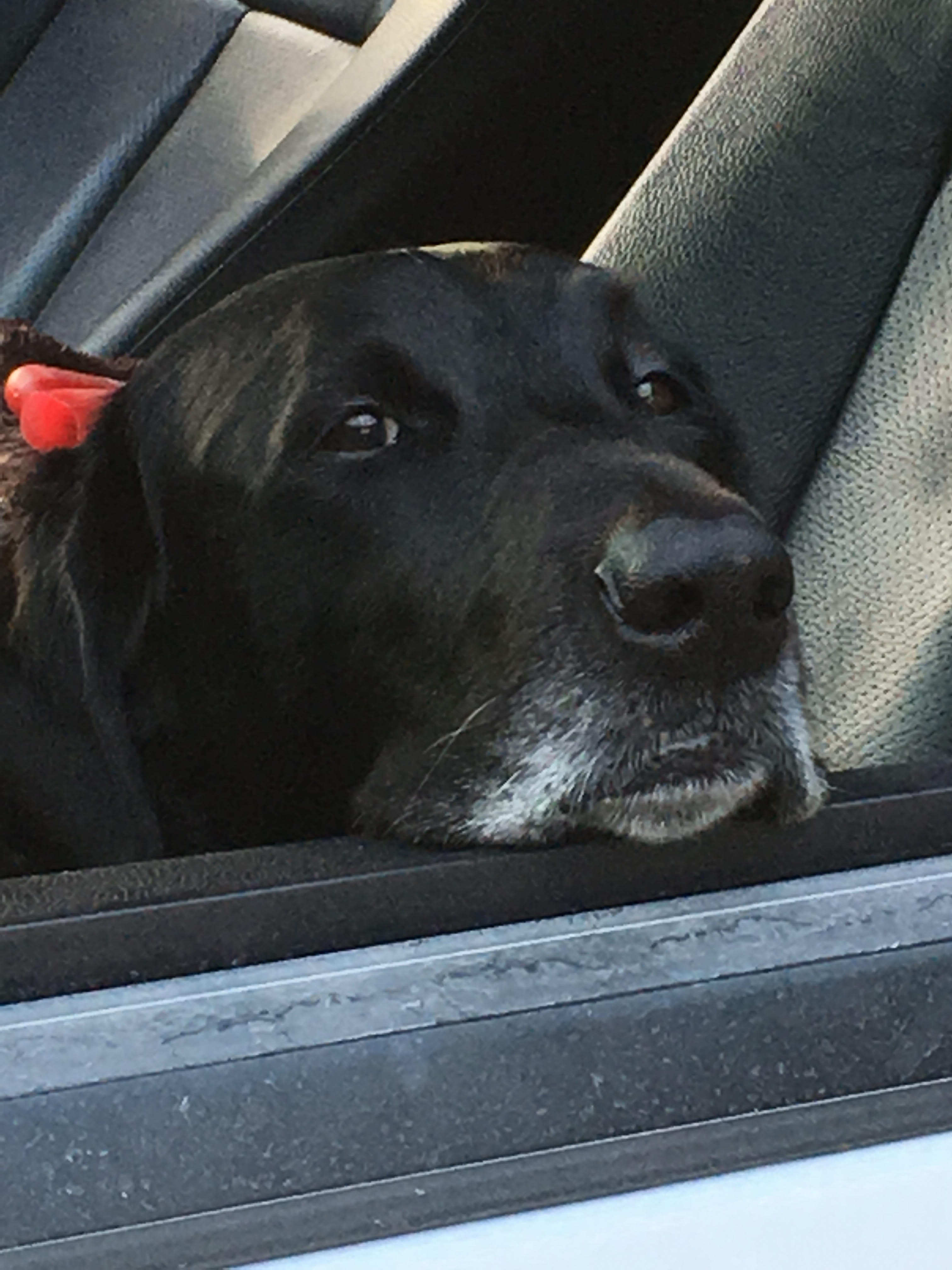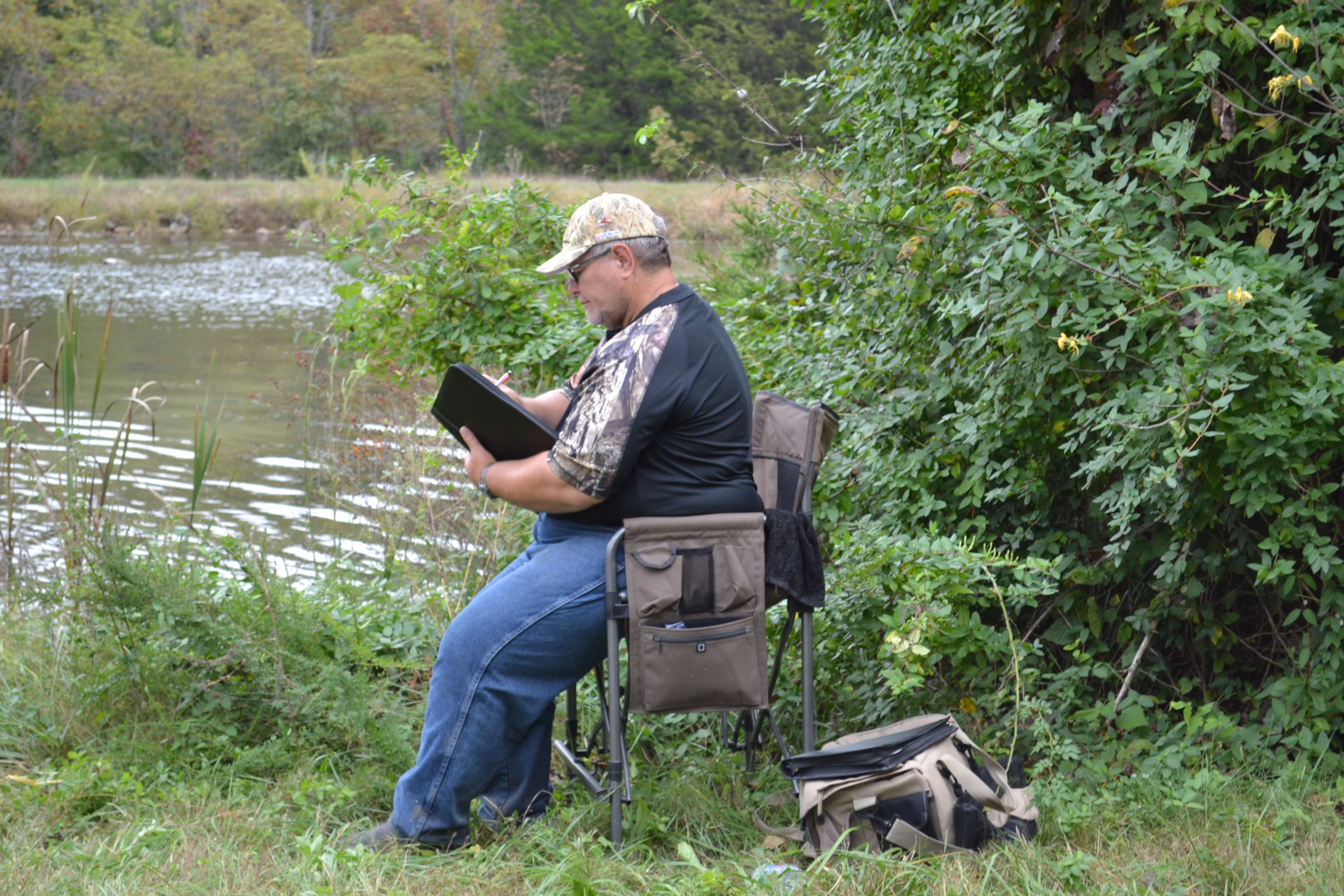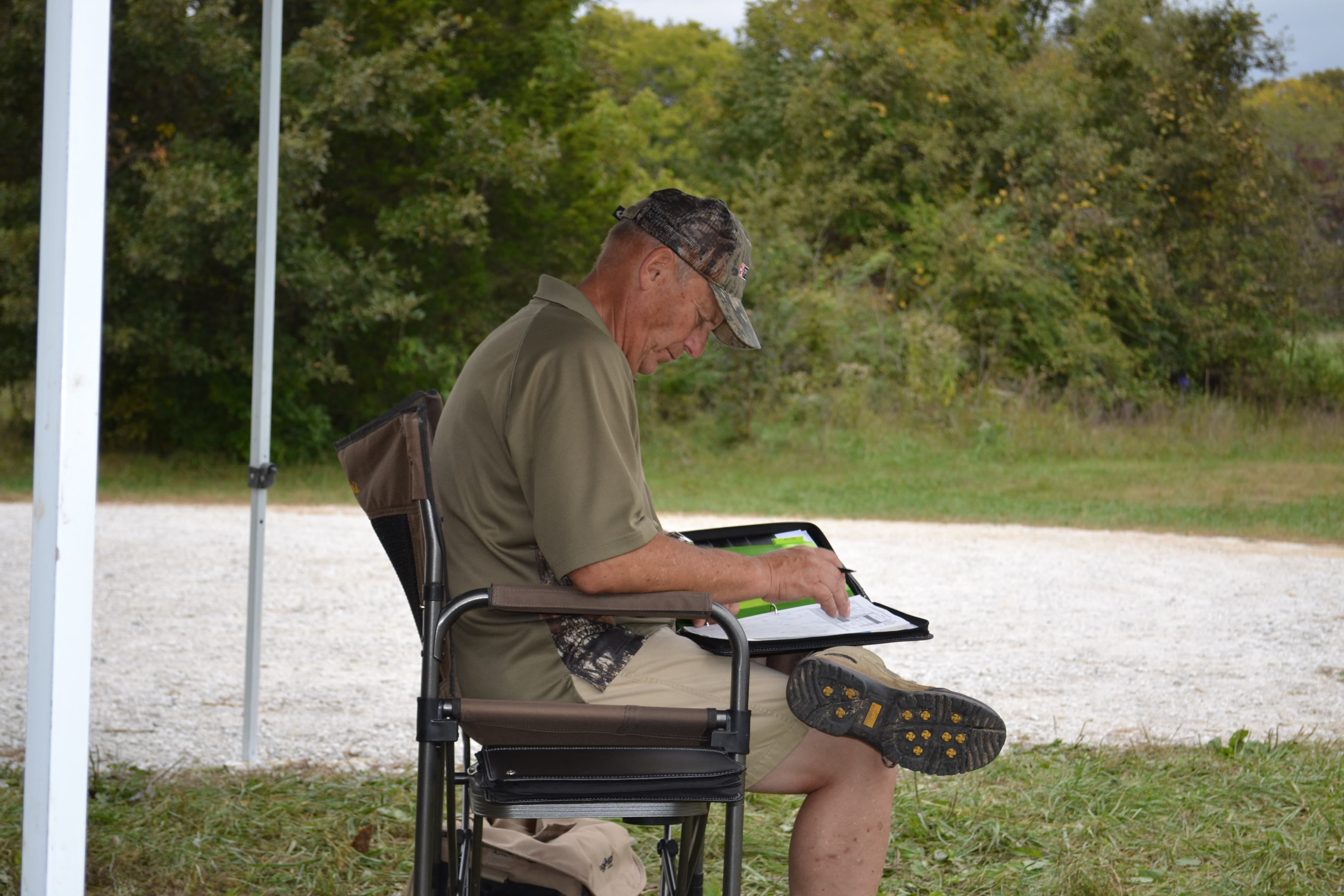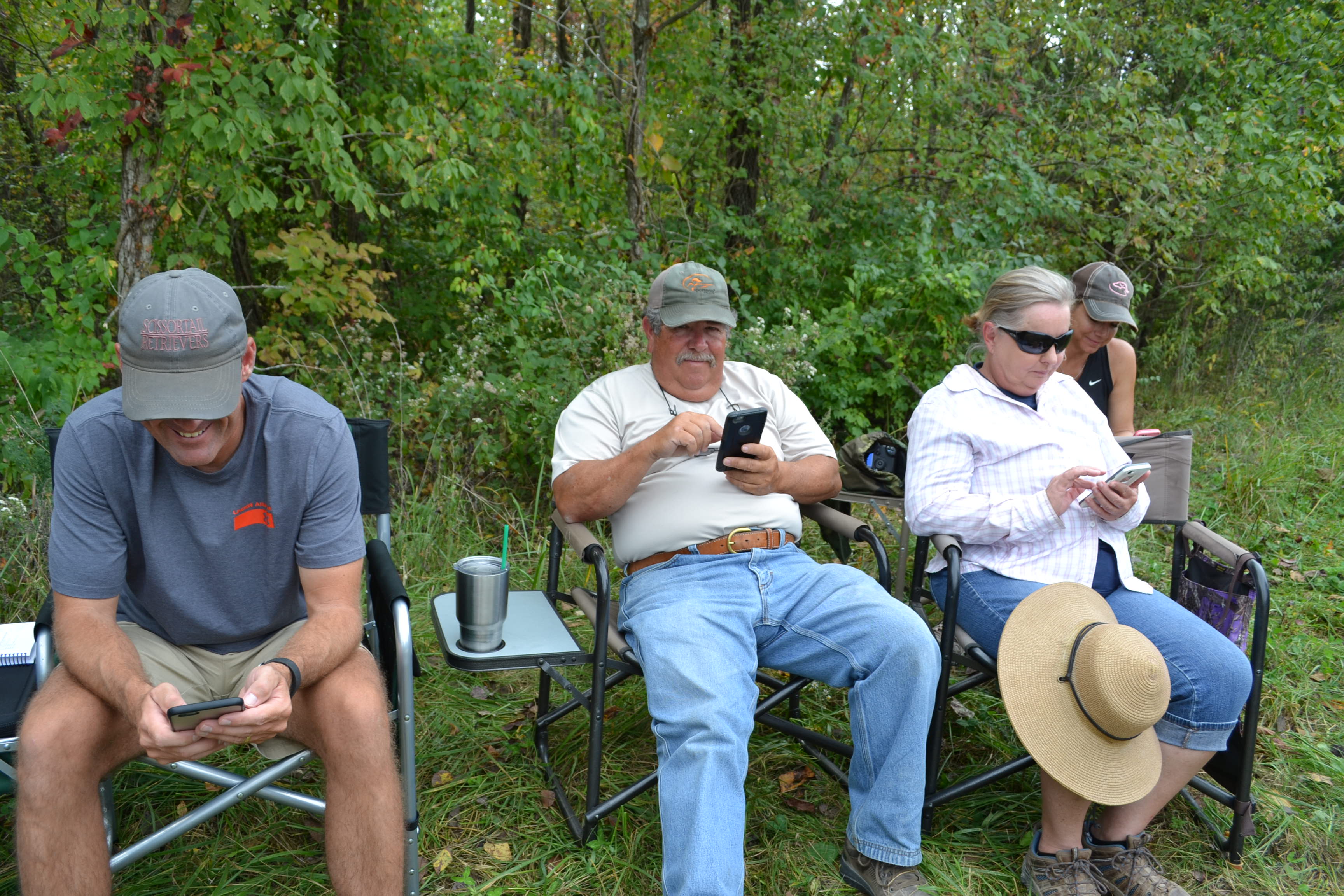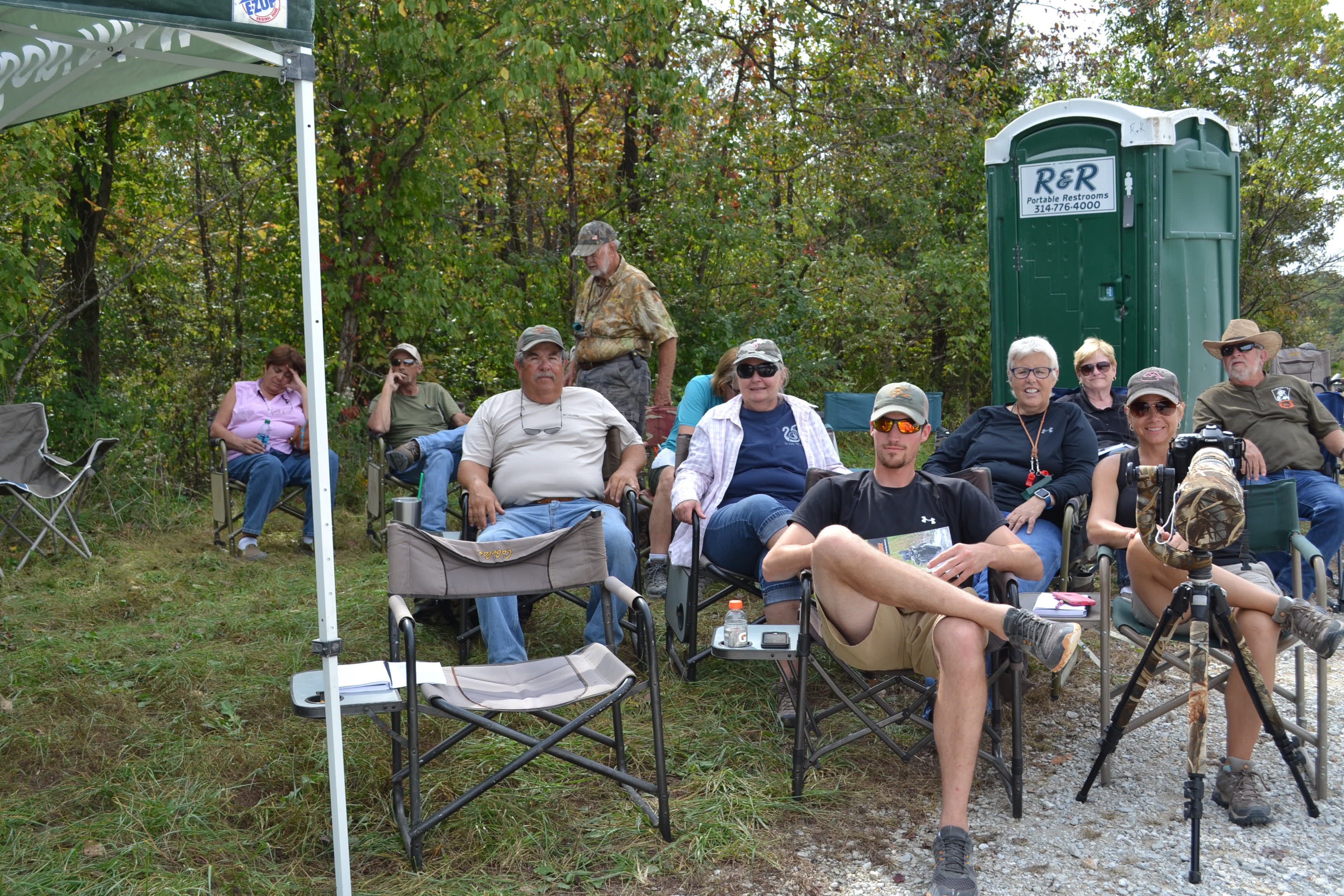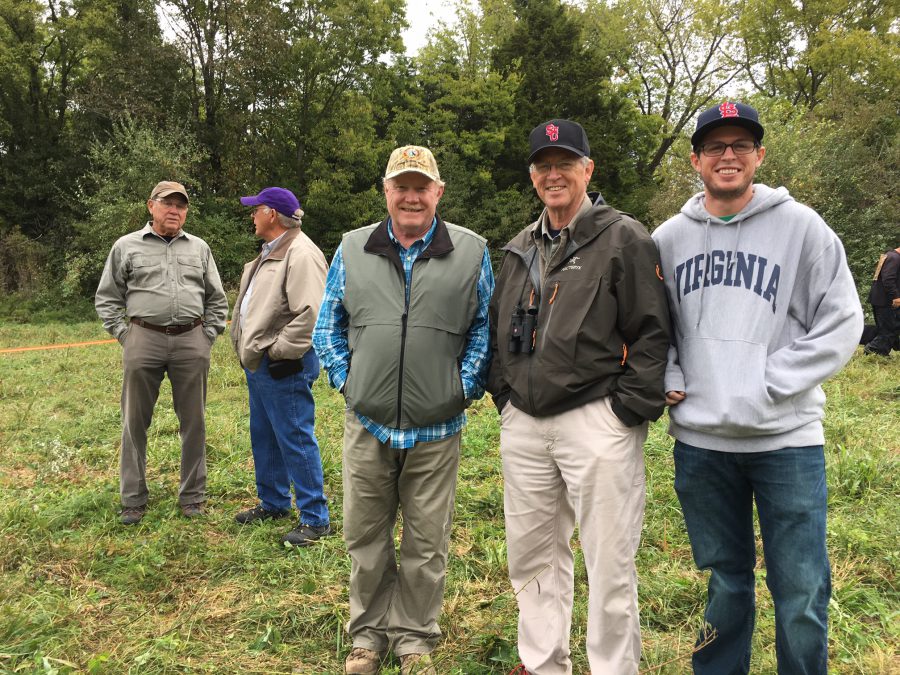
Welcome to the Master National Blog. Click Here to read our previous reports from Saturday, Sunday and Monday .
Saturday , October 8, 2016
Flight D Dorothy Ruehman MNRC Reporter
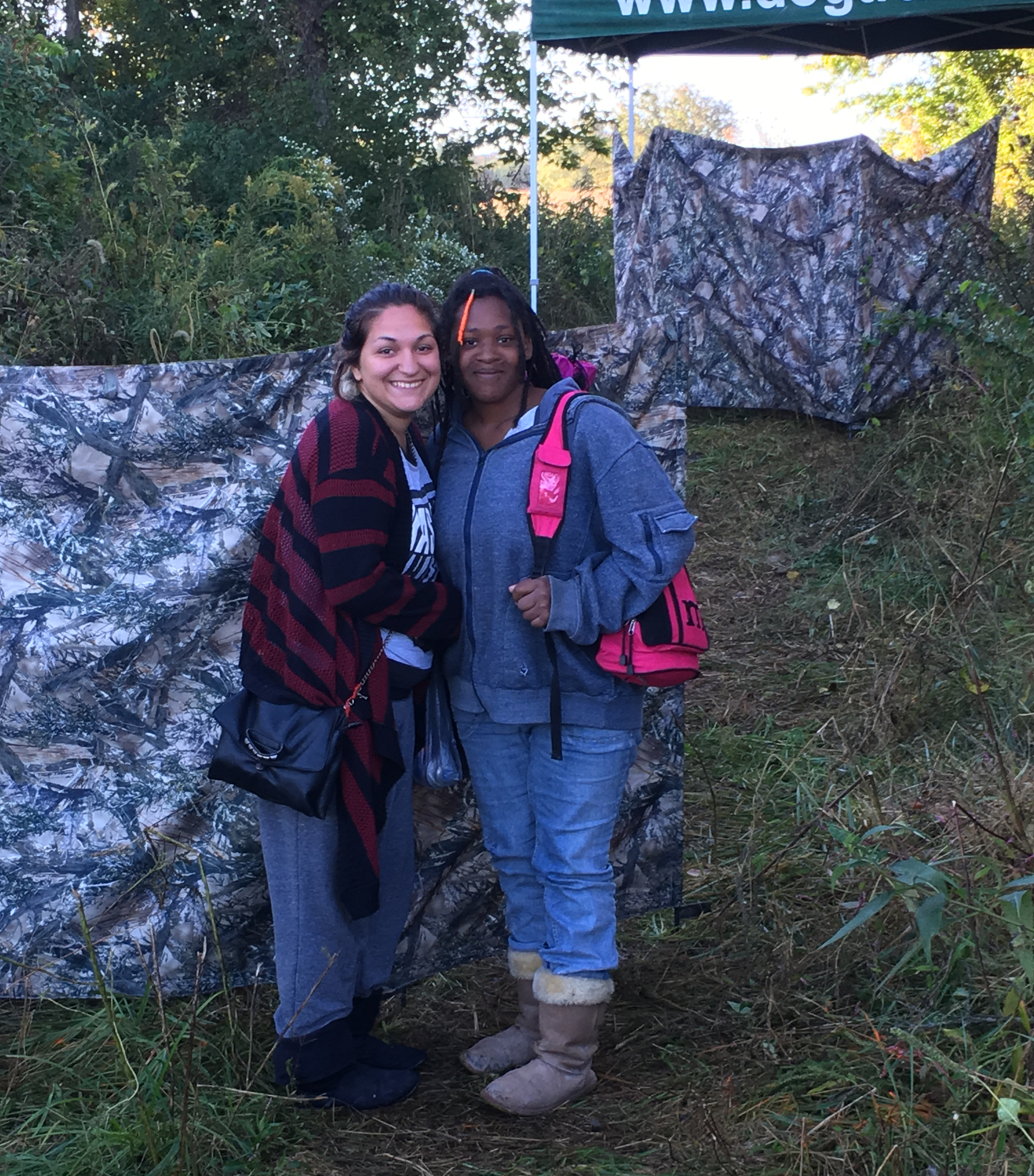
Fifty two retriever teams started the Sixth Series in Flight D at Dove Field Saturday morning. Several spicy handlers decided to call it Triple Threat with Double Trouble!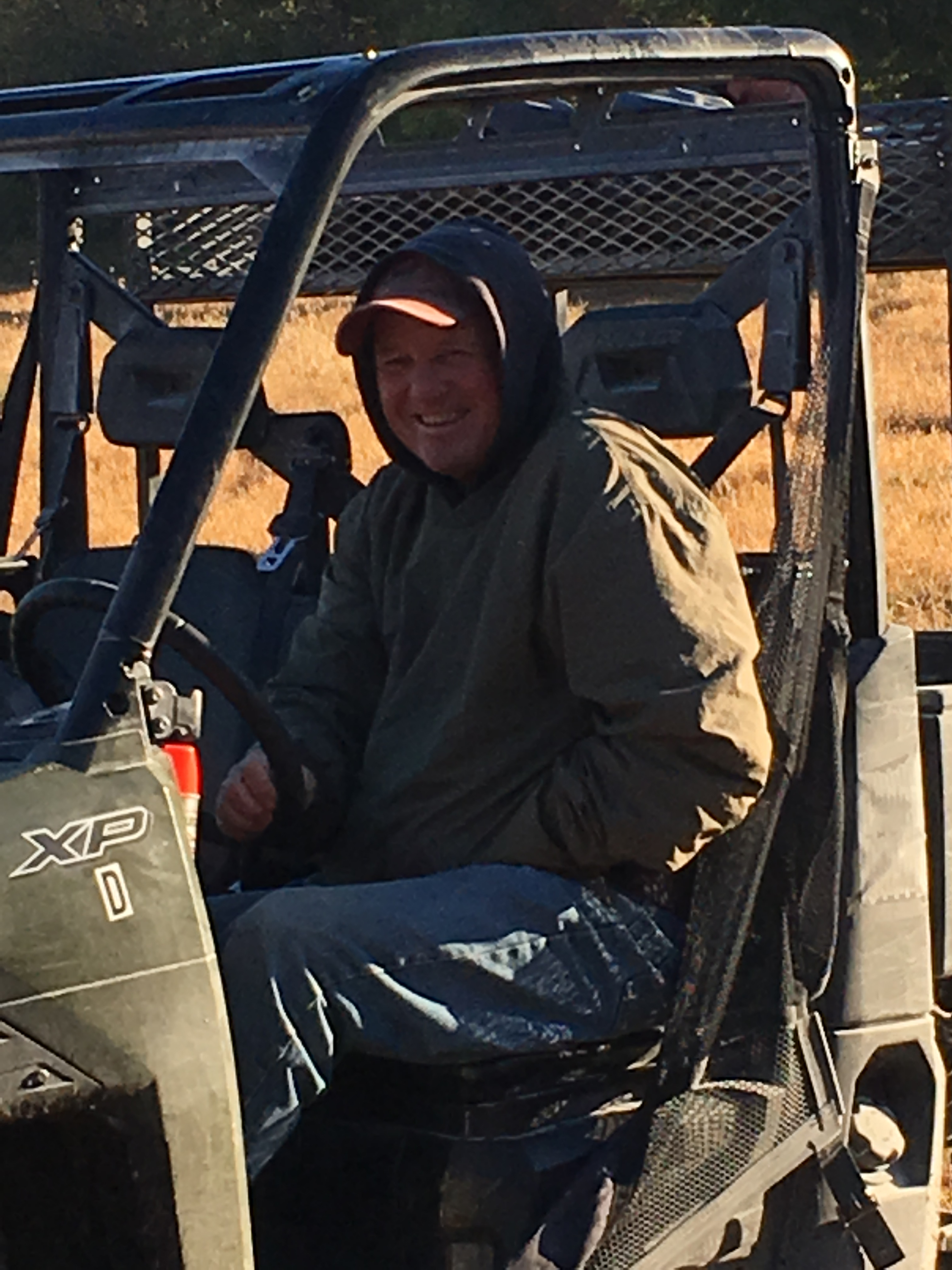
The series is made up of an out of order flyer, two controlled birds, a diversion shot, two challenging blinds and an honor. The site offers a myriad of grasses and other cover both tall and short. Some areas are even plowed.
The blinds seem to give most dogs the greatest trouble as they can disappear in a flash in the tall grass.
All of the retriever teams are wished safe runs and straight lines today!
Ghosted by Ruby Ruehman
Flight F Alice Woodward MNRC Reporter
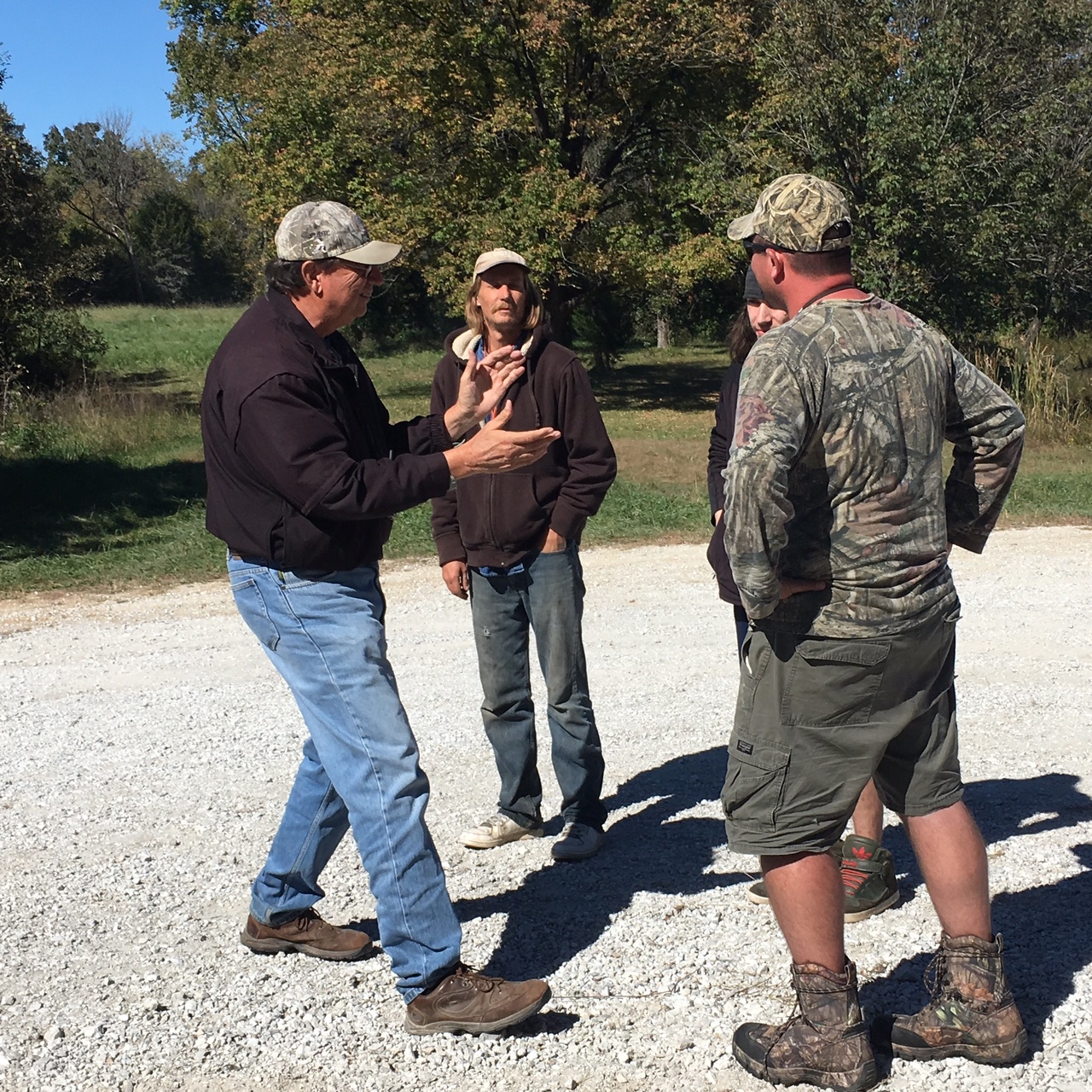
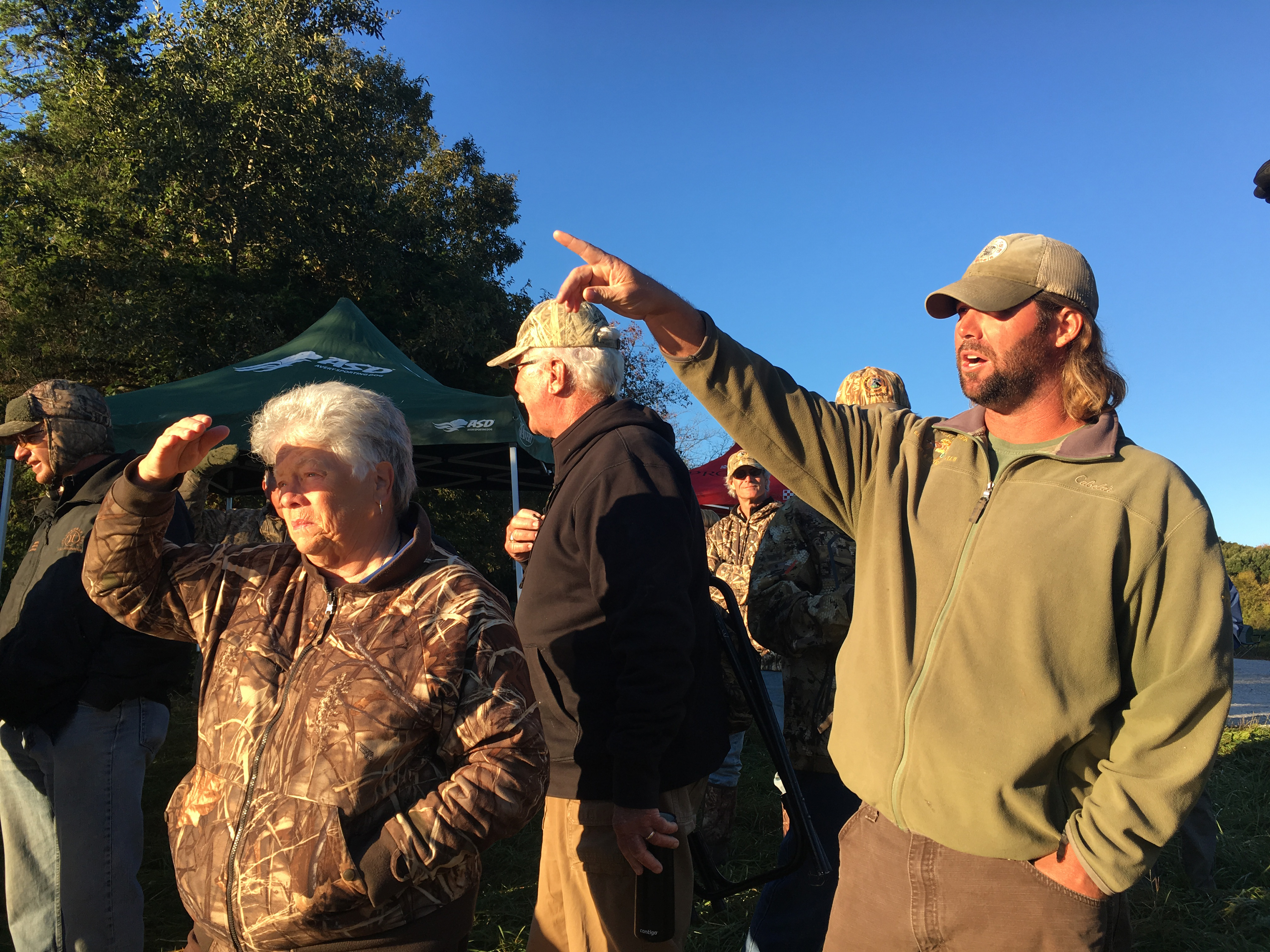
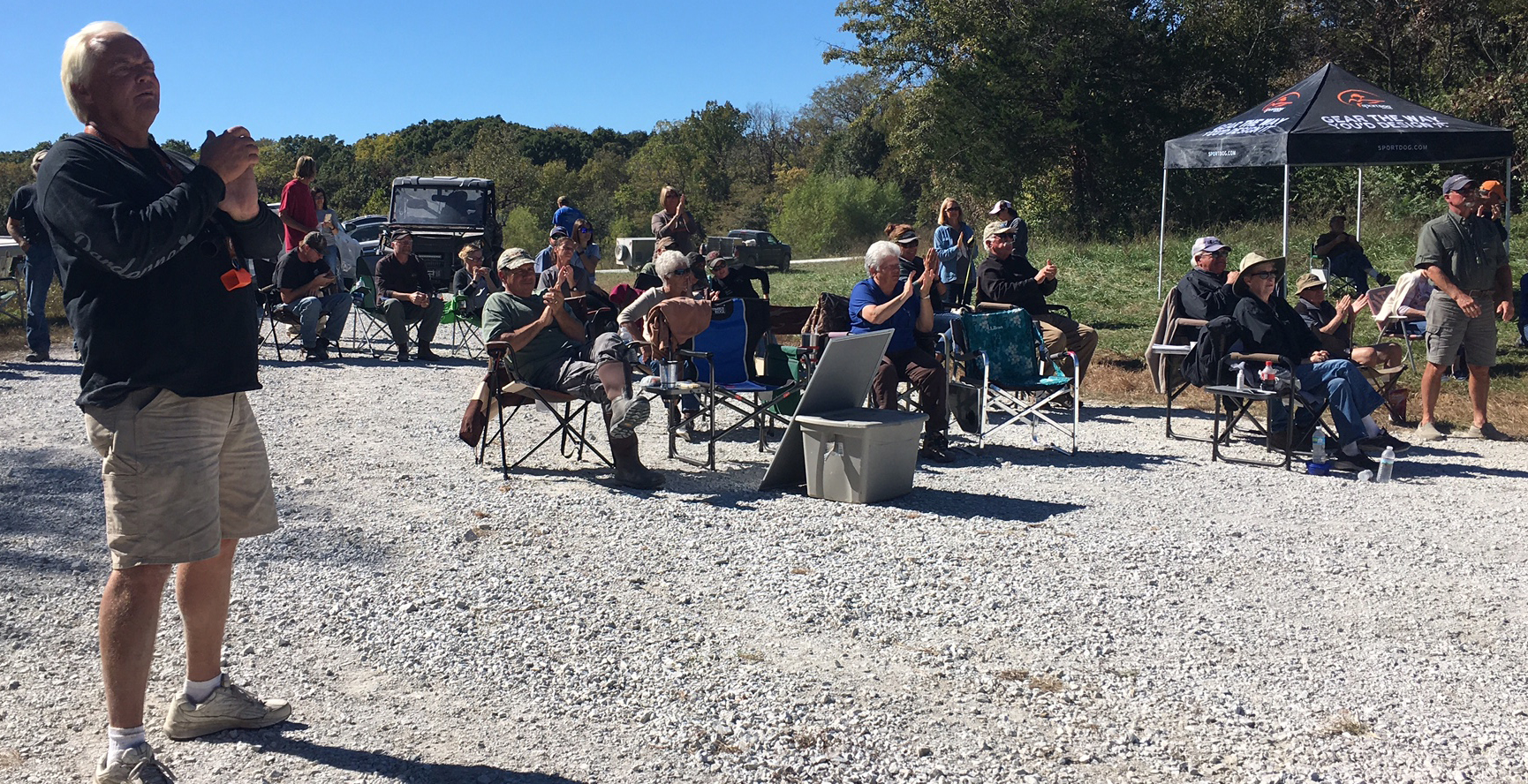
Handlers of 58 dogs have gathered for the last series of the 2016 Master National. For the first day this week a sunny day has greeted the group. The mood is festive. The test will be held set on Lake 26, a picturesque small oval pond surrounded by forests, with a tree-lined meadow rising away from the pond on one side.
The judges welcome the handlers with congratulations for having made it this far, saying that all the dogs in this series are “strong dogs and we don’t want to lose any of you.” Now the mood is even more festive. The scenario is a teal hunt (large teal). The handler is just arriving (aka a walk-up) to find that the teal are flaring here and there as today’s hunting buddies, who are hiding in the forest around the pond, drop three of them. By now you can predict that you are the only one who has brought their dog.
Test Description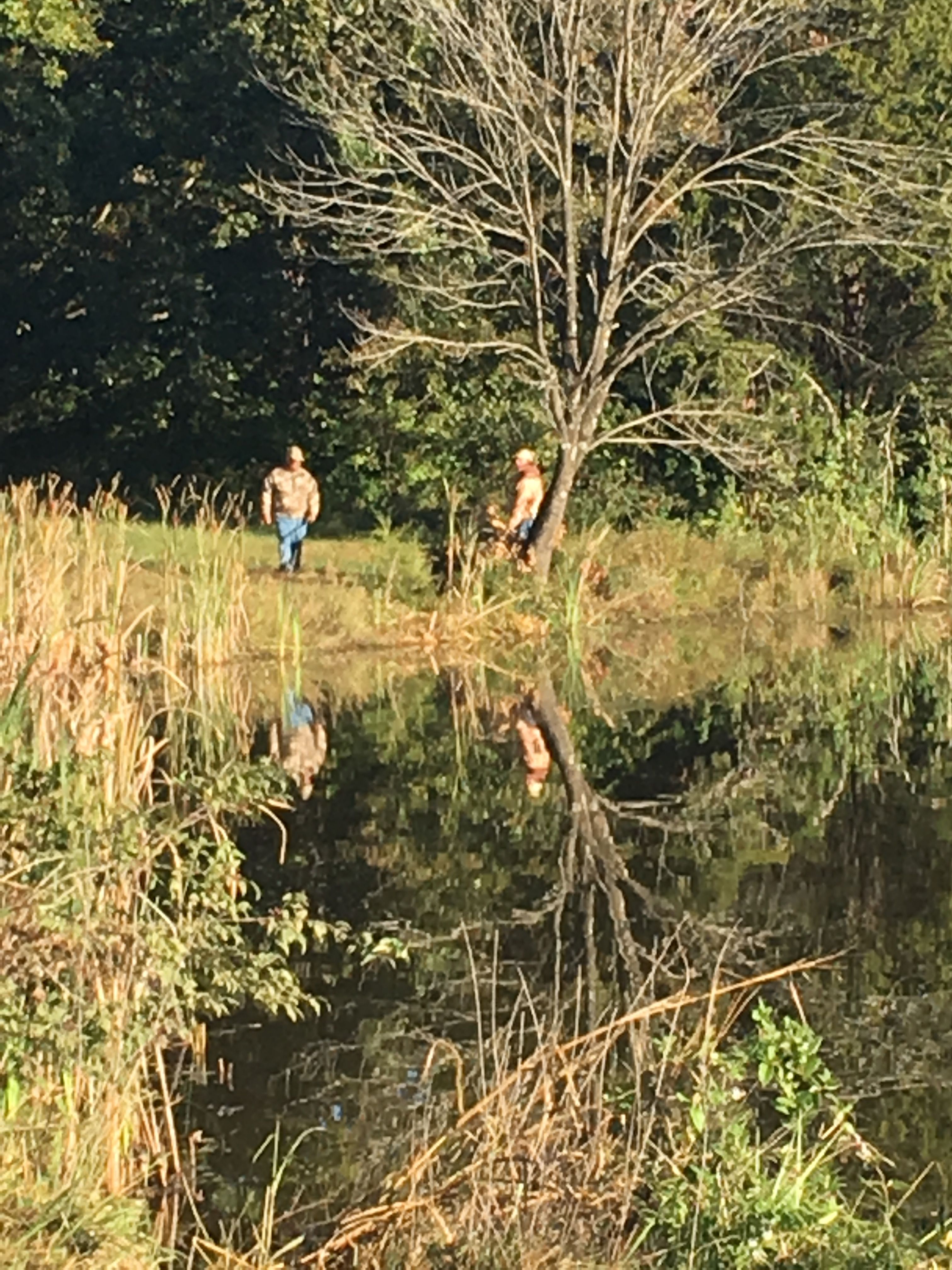
The birds go down middle, left, right (flier). The first bird down, the walk-up bird, is thrown from left-to-right to fall at about 70 yards in a clump of brush at the base of a tree on one end of the pond. A second bird, also thrown from left-to-right, falls somewhat to the left of the first bird and a bit deeper, landing at about 86 yards on a grassy hillside. This hillside bird is a “corridor” placement defined by the trees in the small meadow. Over on the right side of the handler the flier is then shot out into the pond to land at about 30 yards. Pick ’em up.
Test Dogs
The first test dog is “Cher,” handled by Lin Gelbmann. Cher goes to the line at 8:20 a.m. Cher is sent for the middle bird second, exits the water early to establish a hunt that works back in towards the line and is quickly handled. Cher has a hunt in the clump for this bird – apparently it is a constructed clump that has been augmented by some branches. After a brief hunt Cher collects the hillside mark. The second test dog is “Babe,” handled by Corinne Clavey. Babe shows the gallery what a really excited dog thinks of this test but manages to remain steady. Babe skirts the shore for the middle bird and recovers it quickly, followed by a short hunt for the hillside bird. Wind is gentle and varying.
Dog Work
The first dog to run, # 119, goes to the line at 8:39 a.m. The mood is still festive and a round of gallery applause greets each of the the dogs as they leave the line in the 6th series.
The work is strong on this test and as of press time I saw no dog break although it is an exciting flier especially as last bird down after a wide swing. There are some quick handles by teams that evidently “had a handle coming” and elected not to take any chances – and other handles that are obviously needed. The placement of the two memory birds work as a pair to influence the dog work on each of them and BTW, the fall area for the first bird down has been adjusted after test dogs so as to stay clear of the brush pile. Most teams are not handling however and there is a lot of good work. This is a quick test and is taking about 5-6 minutes a dog.
Friday , October 7, 2016
Flight A Jack D. Combs MNRC Reporter
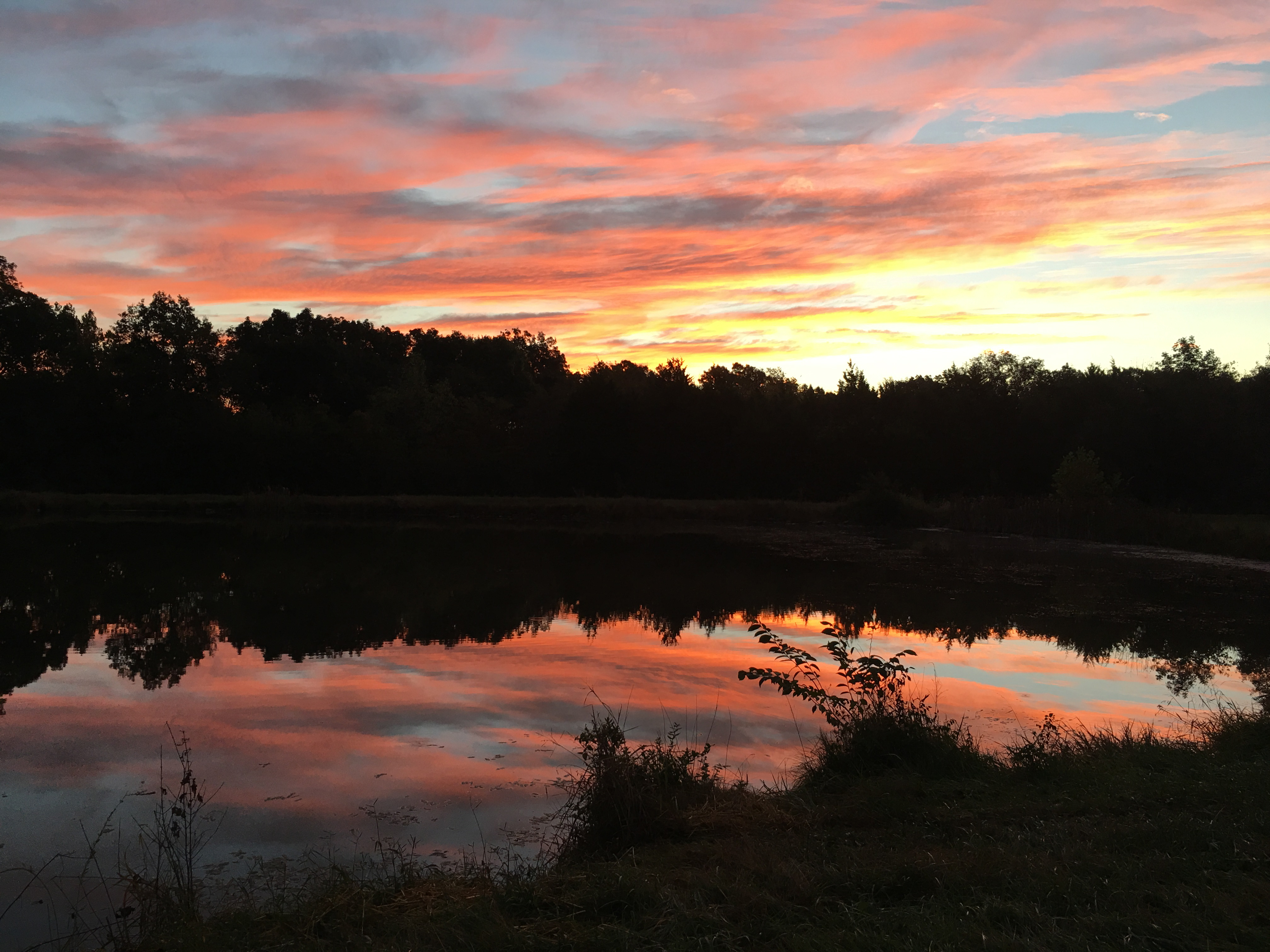
Flight A brought 72 dogs to the 5th series, a land triple with a double blind and an honor. A North North West wind gusting between 12 and 15 mph adds to the change of this test.
One blind is crosswind and the second is into the wind making for very challenging conditions.
Flyer pheasants are also something less than a certainty.
We have had several breaks a dogs not responding to the whistle.
Flight D Dorothy Ruehman MNRC Reporter
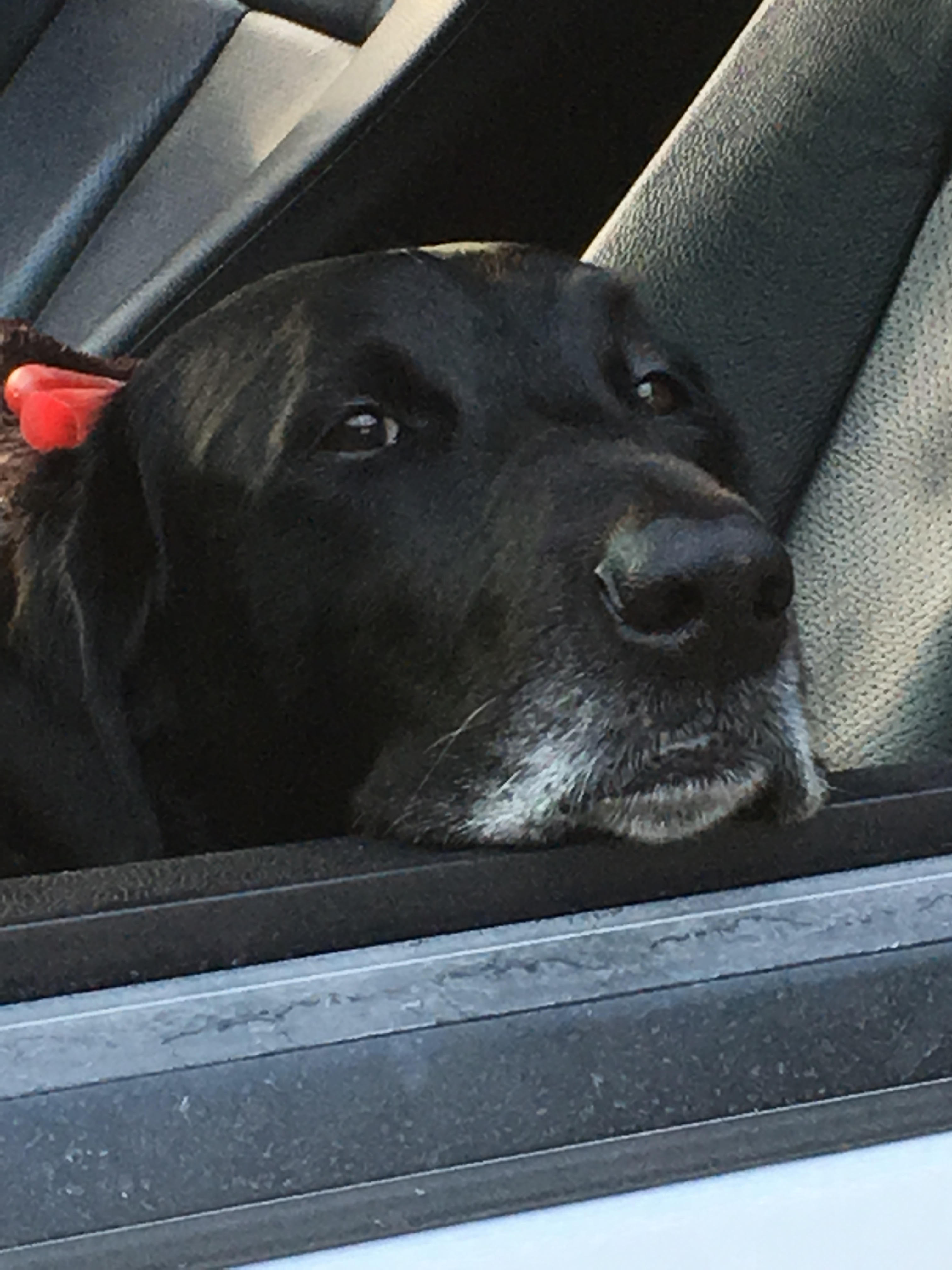
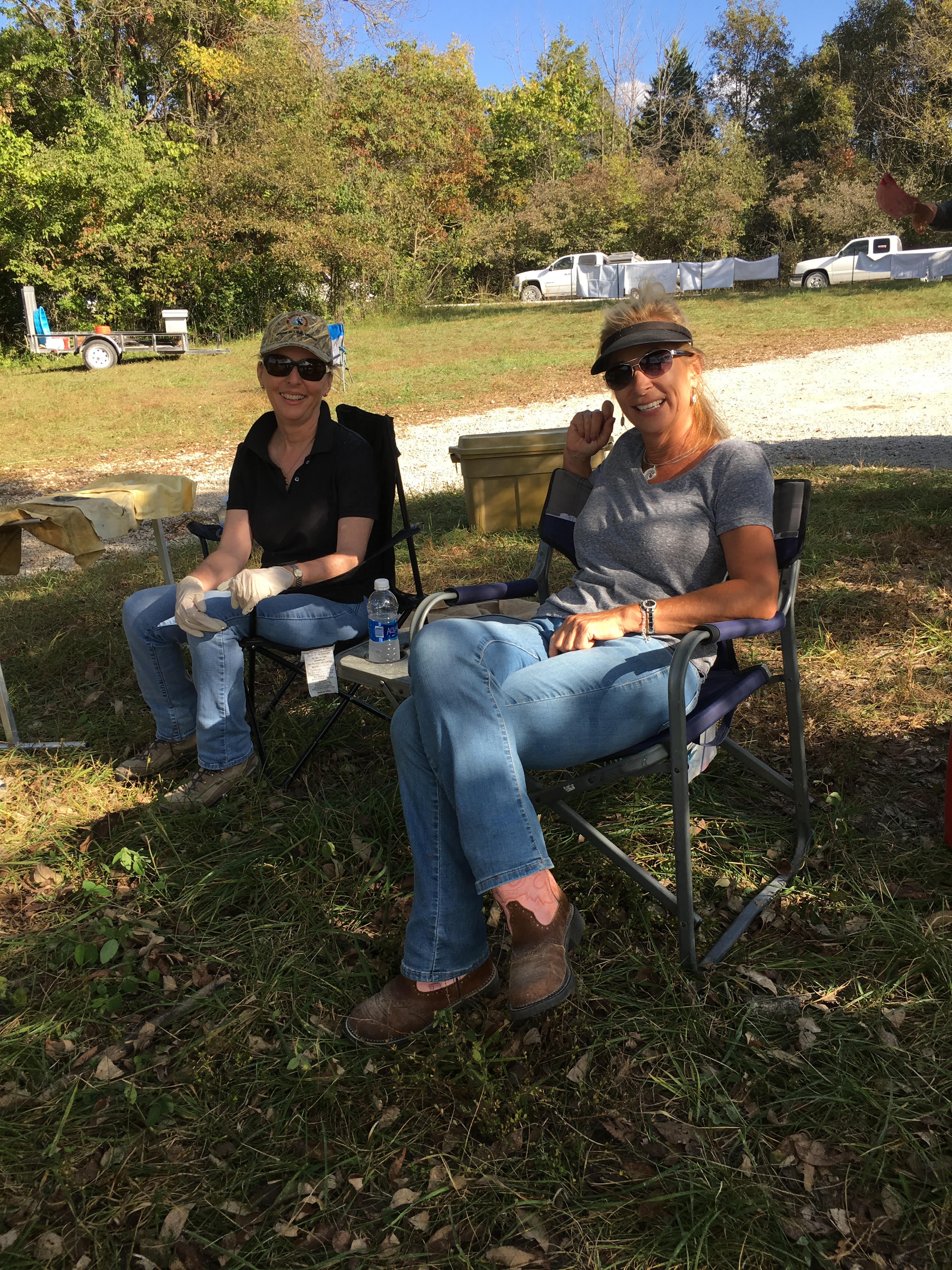 On Friday morning before 8:25 a.m., Flight D faced their Fifth Series with 59 dogs in contention at Master National. Tensions tighten as competing teams prepared to run on what the judges named Lake 37 or Lilly Pad Lake. Handlers thought differently and are calling it Big “Dam” Do-over!
On Friday morning before 8:25 a.m., Flight D faced their Fifth Series with 59 dogs in contention at Master National. Tensions tighten as competing teams prepared to run on what the judges named Lake 37 or Lilly Pad Lake. Handlers thought differently and are calling it Big “Dam” Do-over!
Wishing each team running here today safety, a solid sit, and straight lines to all birds.
Ghosted by Ruby Ruehman
Flight E began its 5th series at Lake 21. The test is a walk up triple. The first bird down is thrown right to left along the shoreline. The dog then turns to the left and a flyer is shot left to right out into open water beyond lily pads. All flyers were sluiced in the water. Further left, the go bird is shot left to right on land tight behind the flyer station.
Flight E Missy Lemoi MNRC Reporter
The first dogs who ran had no problem with the test picking up all three marks in three minutes. The wind was blowing in the dogs’ faces helping them find the birds. As the test proceeded, the wind became gusty and started to affect the flyer. Instead of flying well out into the pond, the flyer landed closer to the gun station making it more difficult for the dogs to find the bird.
If the dog picked the flyer up last, the wind blew it back into the shore by the gunning station. It was difficult to see the dogs when they went into the water near the flyer station, so the handlers could not handle their dogs easily,
The go bird gave a few dogs trouble. They made a few loops near the fall area then left and went toward the flyer. We had one dog break on the flyer and a few dogs switched. With the direction of the wind, the first bird down was easily found by dogs who ran the bank to it. A few dogs stayed in the water past the bird, got out and hunted deep on land before working their way back down to the edge of the water.
The flight finished running their test at 12:30 PM. Shortly thereafter, we were informed that we were finished for the day.
Flight F Alice Woodward MNRC Reporter
FRIDAY TESTING – LAKE 30 – FLIGHT F’S 5TH SERIES
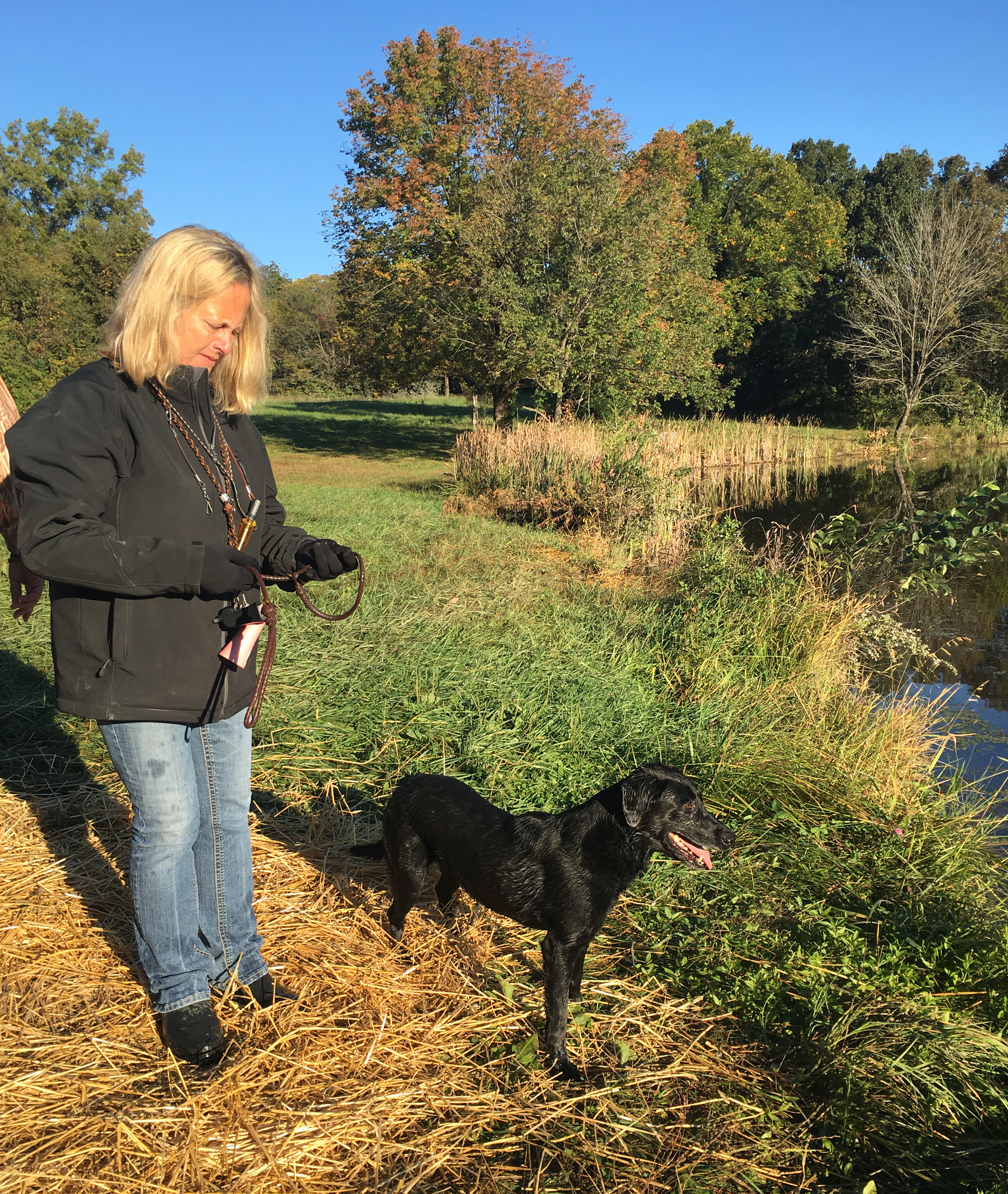
70 dogs are back for the 5th series, which is held at Lake 30. A mandatory bitch re-check for all female dogs is being held as the gallery gathers for the test. The handlers are called to the line at 8:02 a.m. for the scenario and test dogs. The judges give the hunting scenario: It’s a duck hunt (for normal sized ducks instead of the giant species at the dove hunt). Your buddies Thibideaux and Budreaux have slept in and aren’t here — you don’t know the names of your new hunting buddies. However, once again, it appears you have the only dog.
Test Description
This is an all-dead-bird test set on the end of a large pond. The marks go down left, right, middle, and are followed by a water (as the judges emphasized) blind. The handler stands in a holding blind with his dog outside the blind on the left side of it and blows his own duck call to start the test. The first bird down appears on the handler’s left and is thrown left-to-right angle back across the end of the pond to land on the grassy shore at about 78 yards. The line to this bird is a shoreline through the water – if the dog does not cheat (it’s an easy one to cheat).
The second bird is thrown left-to-right to land on the handler’s right and in front of (or sometimes in) bushes at the base of a couple of trees, landing at about 84 yards. It’s a classic “barrier bird” with inviting corridors around both sides of the bushes and a lot of visibility problems for a hunt in the area of this fall. The third bird is thrown right-to-left to land out in open water near a lone dead (drowned most likely) tree. This bird is in front of the handler, at about 63 yards. The line to this bird angles into the water and passes to the right of a small decoy spread and an area of lily pads.
A diversion shot is fired as the dog is returning with the right hand mark and the blind is planted as the dog returns with its final mark. The blind is placed at about 78 yards, lying on the left end of a point that juts out beyond the middle bird. The line to the blind is under the arc of the last bird down, and goes through a mix of swimming and lunging water. It angles into the water, trims a small point, then crosses a small bay for an angle exit to the bird. The blind is marked by a partly submerged orange stake that is just to the left of the bird placement.
The wind during this test varied between cross winds (usually from the left) and occasionally a wind in the face on some of the birds. The weather in the morning was “threatening,” with dark clouds and a strong wind. However no storm ever materialized and the day finished up in the sunlight. A strong wind at times increased the challenge of getting that all-important “cast into the wind” on the water blind. Strong winds also could cause the “go bird,” being thrown straight into the wind, to land short – meaning it would land directly on line to the blind instead of arc-ing over the line to the blind.
Test Dogs
The first test dog was “Lady,” handled by Lin Gelbmann. Lady ran three clean marks and was “fat” on the water blind, entering the water early and then swimming wide off the shore and out into the lily pads before Lin was able to handle her back to the blind. After this test dog ran, the judges announced that handlers must send for the blind from directly in front of the holding blind not off to the left of it. This designated launch point made it more of a challenge to get the dog into the water.
The second test dog was “Spanky,” handled by Larry Lomax. Spanky ran two clean marks and had a wide line on the right-hand land bird but quickly recovered, and ran a strong blind.
Announcements
At the end of the test dogs’ runs, the marshals announced the numbers of the three bitches that still needed to be presented for the bitch check and stated they would not be allowed to run until checked.
Throughout the morning there were various traffic and parking announcements and one halt to testing while handlers moved their vehicles into new parking areas.
Dog Work on the 5th Series
The first running dog, # 95, went to the line at 8:35 a.m. For the most part work on this test was strong, with the left-hand bird being easily recovered without hunts – whether the dog swam “fat” in the water, ran the bank, or took the true line. The wind was helpful to some dogs in getting this bird clean. The right hand bird, the one in front of/inside the bush, gave teams more trouble but a helpful cross wind was an aid in preventing complete disasters for those dogs that had hunts on this mark. There were some handles on this bird and there were also dogs that seemed to know exactly where it was and put their noses on it (good bush-markers?).
The “go bird,” floating in the water, produced some hunts as dogs were distracted by lily pads in the area of the fall. Also, a dog with a lot of momentum could splash through this fall area and get out on the point beyond, where the blind scent and a blind planter’s trail could lead a dog into a lot of trouble. Many dogs recovered the “go bird” by running the bank until opposite the bird and then hopping in for a quick retrieve, showing their talent as efficient duck dogs.
The water blind saw many excellent jobs including a perfect initial line from many dogs, but, as expected, there were also jobs where the dog could not be gotten into the water until it ran out of land to run on despite many whistles, and other jobs where a dog wanted to stay out in the water and stay away from the land. Once again, the wind from the left – if not too strong – proved to be the handler’s friend, making it easy to put the dog on the blind once he landed on the point. A few dogs actually swam around the point on the left side of it but were quickly handled back into the blind. The size of the “big water” beyond may have helped influence these point-circlers to beach promptly.
Wrap-Up
Work on the 5th series was completed just before 5 p.m. and it was announced that the next test would be at Lake 26. One of the other flights was running behind all the others, so before a 6th series could be held, a Committee determination would be made as to whether there would be a 6th series, because if not all Flights can complete 6 series then only 5 are held at that Master National.
Thursday , October 6, 2016
Jack D. Combs MNRC Reporter
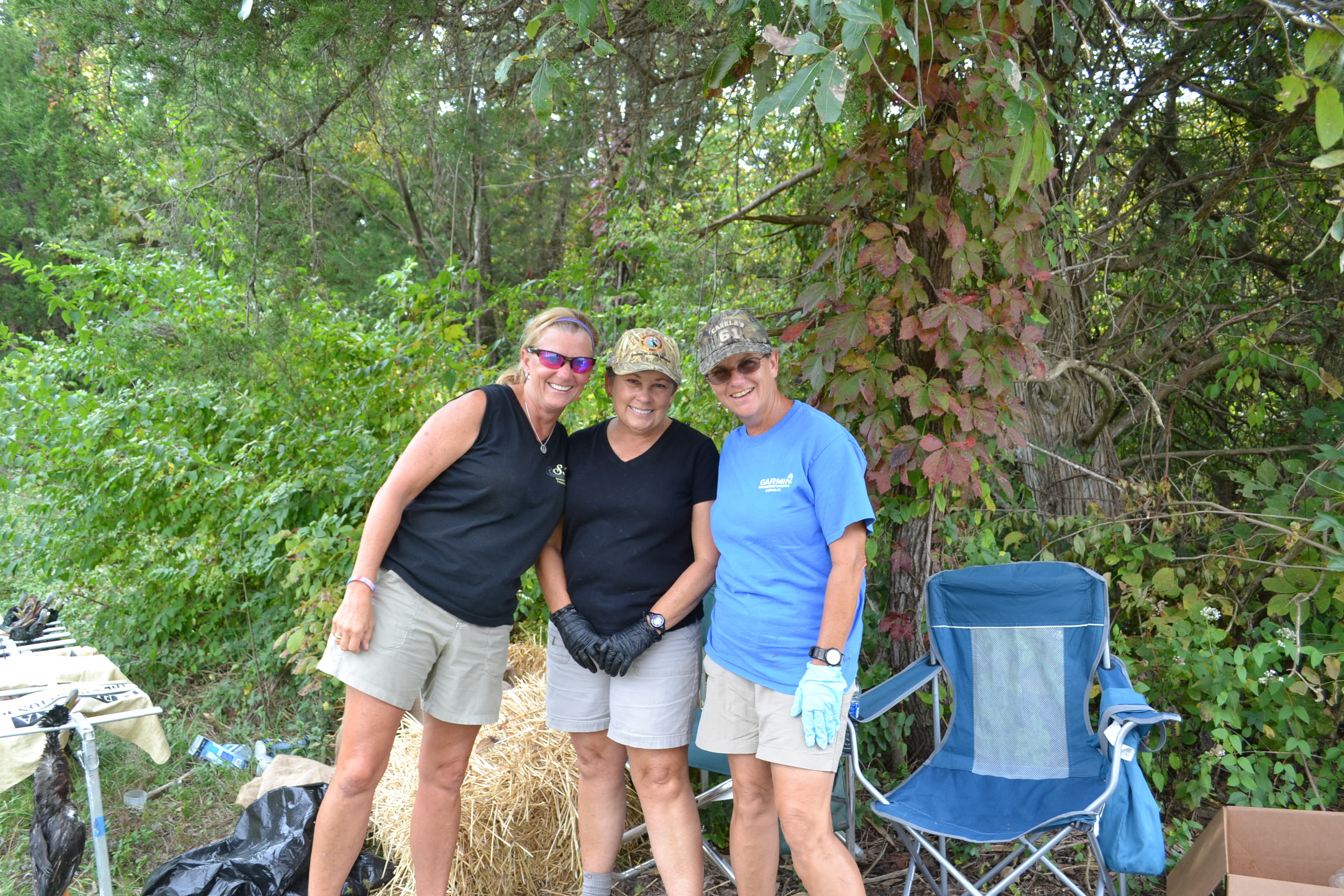
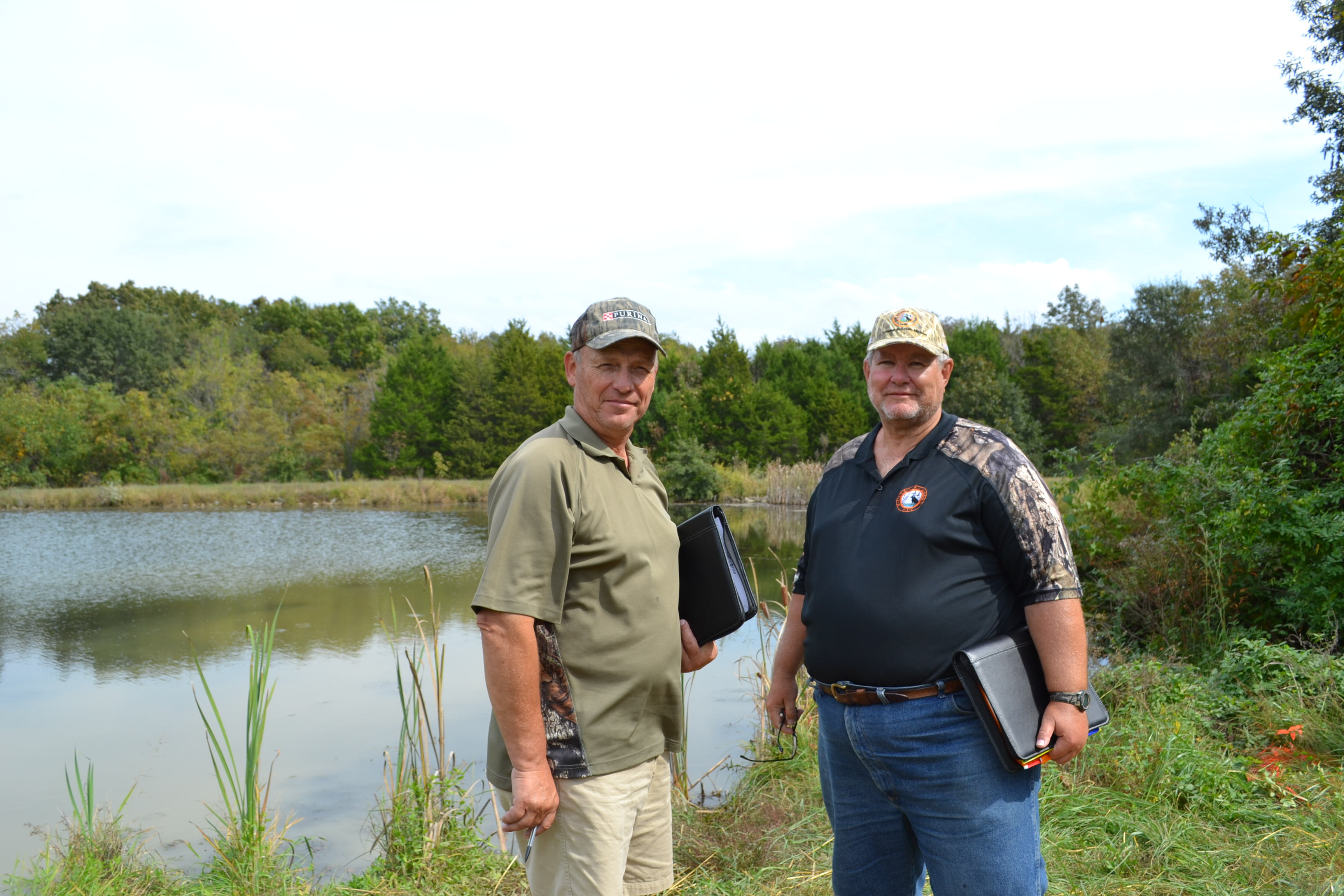
Flight C Frank Barton MNRC Reporter
Flight C started back up on the ABC field with a test dog running at 7:30 . The test quickly put into play that old adage, “give a dog room to run and they will” Long Hunts on the pheasant were observed all day long; often time resulting in handle. The middle go bird did not cause to many problems and the left hand bird did not either. But the flyer ruled the day as the key money bird of the test. Unfortunately there were a few double handles and some pickups on the flyer.
The wet clover from the morning dew did not help scenting conditions on this pheasant test. However, the cooler morning temperatures helped “jack up” these fine hunting retrievers to the point that some of them were unable to handle the temptation of the flyer with another dog on the line. There were several breaks by working dogs, but the honor dogs stayed steady…..no doubt from the fact that they were tired from the seven minute and 5 retrieve test.
As they day warmed up the dog work slightly improved. While there were fewer handles on the pheasant flyer, many of these handles were not clean giving the judges Bruhin and Judd lots of opportunities to score trainability. At 1:30 the wind picked up and the dog work was noticeably better. When the wind dropped back down 45 minutes later the work reverted to the status quo.
The test concluded when dog #70 left the honor bog at 4:53. The flight C crew had met its goal of completing 4 series by t he end day on Thursday. The judges reviewed the score sheets and gave them to Stake Marshal Allan Dillard. 20 dogs had been lost on the difficult land test and 70 dogs would start the 5th series test at Lake 11 in the morning.
Flight E Missy Lemoi MNRC Reporter
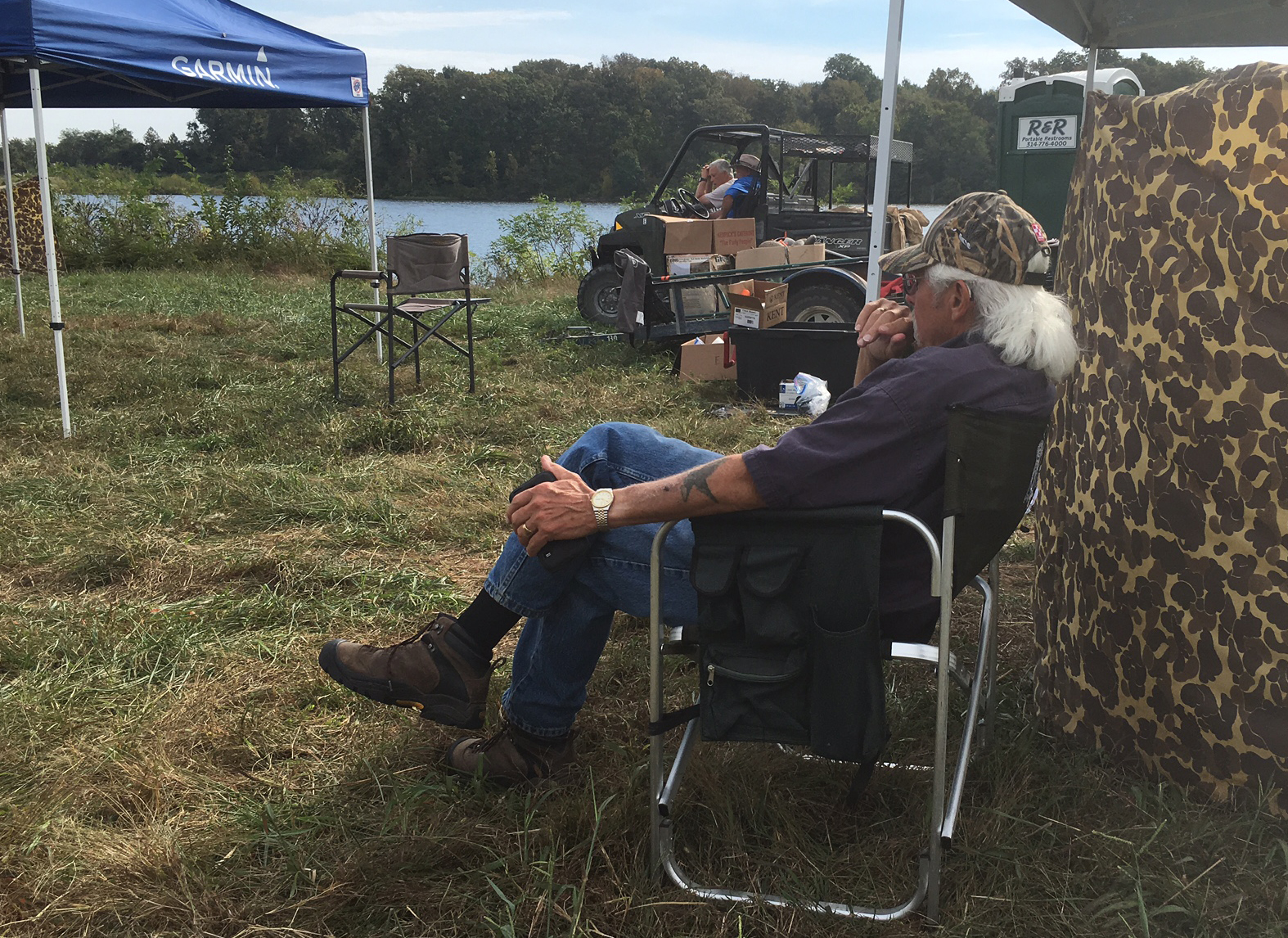
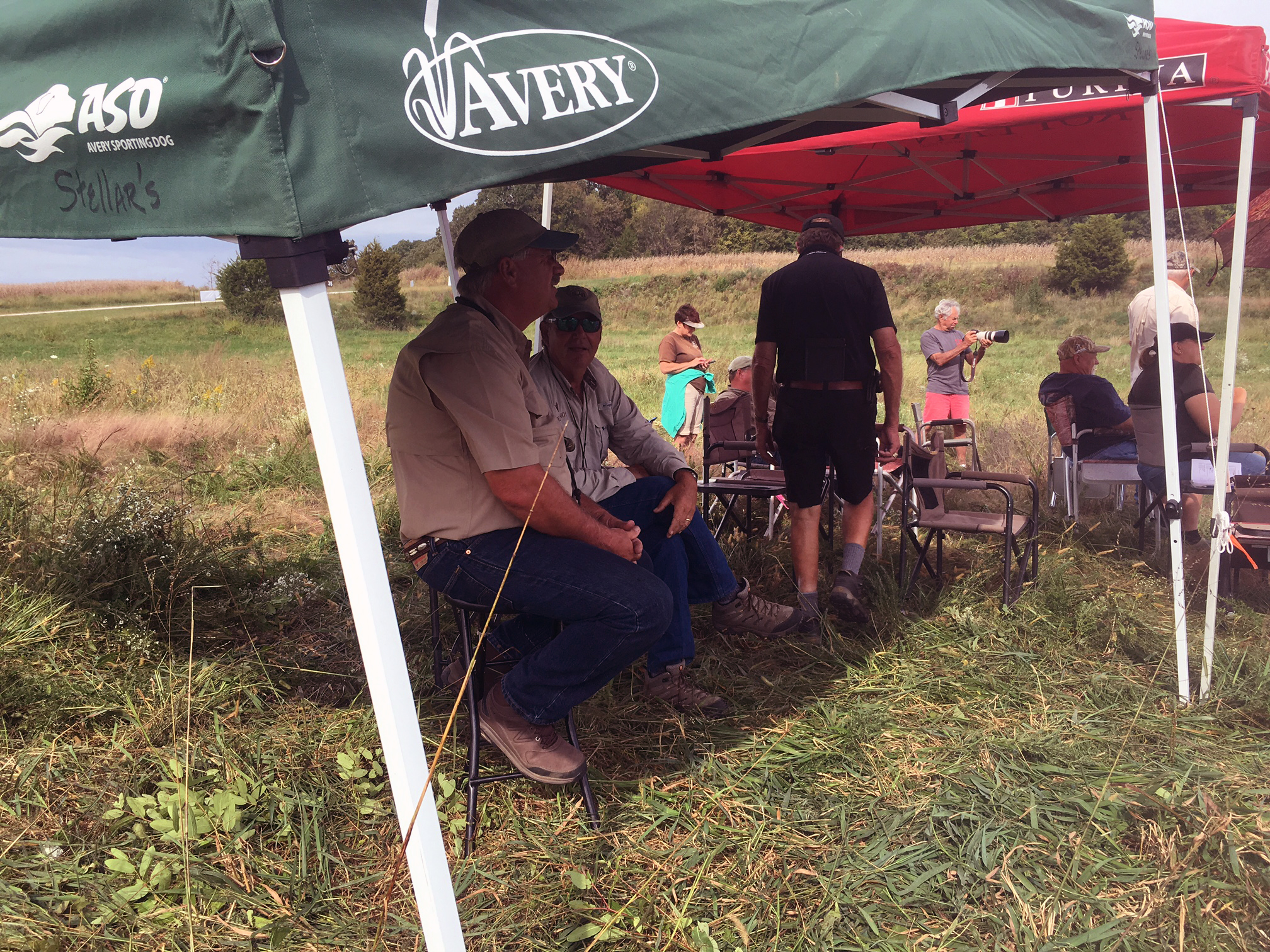
Flight E continued with its 4 th series at Lake 35. The wind had shifted just a little and was blowing a little stronger than yesterday slightly left to right and downwind from the line. The dog work was about the same as yesterday with the dogs picking up the marks cleanly. The handlers were opting to pick up the left mark second in most cases due to the stronger wind. The splashing go bird enticed two dogs to break today, and one break yesterday.
The blind continued to make the handlers work. Lots of whistles and carefully calculated casts resulted in dogs threading the corridor along the shoreline. Handlers were careful to keep their dogs off the shore and keep them under control as they ran the blind.
The last dog came off the line at 5:30 PM, the site was cleaned, up and the group moved onto Frankie’s party!
Flight F Alice Woodward MNRC Reporter
COMPLETION OF TESTING ON THE DOVE HUNT – FLIGHT F’s 4TH SERIES
The remaining 65 dogs ran on Thursday on the “Dove Hunt for Large Doves” held at the Dove Field. Testing began about 8 a.m. Average times were a bit slower than theWednesday afternoon blitz, as there were several no-birds as well as a brief unscheduled interruption by archery hunters who arrived to set up their deer stand in the morning for the special draw hunt to be held this coming weekend.
Dog Work on Day Two of the Dove Hunt
It appeared that the work smoothed out as the day progressed, with fewer handles and smaller hunts than on Wednesday. This is not unusual in this reporter’s experience when terrain has been used by a lot of dogs. Also, those handling multiple dogs are able to use their previous trips to the line to help them strategize for their later runs, further improving the Flight’s average success ratio.
On the left-hand mark, towards the latter part of the day many dogs were able to line the bird on this challenging placement even though by this time one of the trails to this mark funneled dogs into the under-the-arc blind (savvy handlers tried to avoid this trail). The build-up of scent at the right-hand blind, which was located under the arc of this mark, proved a trap for some dogs and only became worse as the test progressed. but for those dogs who stayed higher on the hill the work on this bird was excellent.
Over at the flier, things were going better than they had on Wednesday, as scent built up sufficiently in the area of all the flier falls to hold dogs to persevere on their hunts even though the falls were still varying.
Wrap-Up
Testing consumed the day with the bye dog leaving the line at 4:55 p.m. No time to start another set-up before Frankie’s Party this evening so everyone was quick to pack up and get ready to party hearty at this Master National tradition. Flight F will go to “Lake 30” for its next test, which will be its Fifth Series.
Wednesday, October 5, 2016
Flight C Frank Barton MNRC Reporter
Flight C resumed its testing on the Lake 21 test and were running dogs before 7:30am. The morning saw heavy overcast skies that soon produced a light rain. It was obvious that the visibility factored into the test as many of the early dogs handled on both the flyer and the right hand bird. Later in the day fewer dogs handled on the right bird, but the middle flyer on the other side of the lily pads was as difficult as the day before.
Flight C moved quickly and efficiently to the ABC for a Land Triple, Double Blind and Honor. While the test was being set up a pheasant was observed out in the field in the area where marks would be thrown. Since the live gunners had not yet arrived, Event Secretary Frank Barton took matters into his hands by taking one of the single shot popper guns, some live loads and went out on a pheasant hunt. With his dog, Delta, quartering the field, flushing, and retrieving he bagged three pheasants before declaring the field clean. Judge Alan Bruhin created a scenario around the activity to set the stage for the 4th series test.
Flight C ran 6 dogs on this test, then suspended testing to allow the sun to fall below the tree line before resuming testing. With 90 callbacks total, the goal was to run 10 dogs total in order to build a little cushion in the ability to finish the test on Thursday. Once the sun set behind the trees testing resumed and another 4 dogs were run before the judges suspended due to lighting.
Flight D Dorothy Ruehman MNRC Reporter
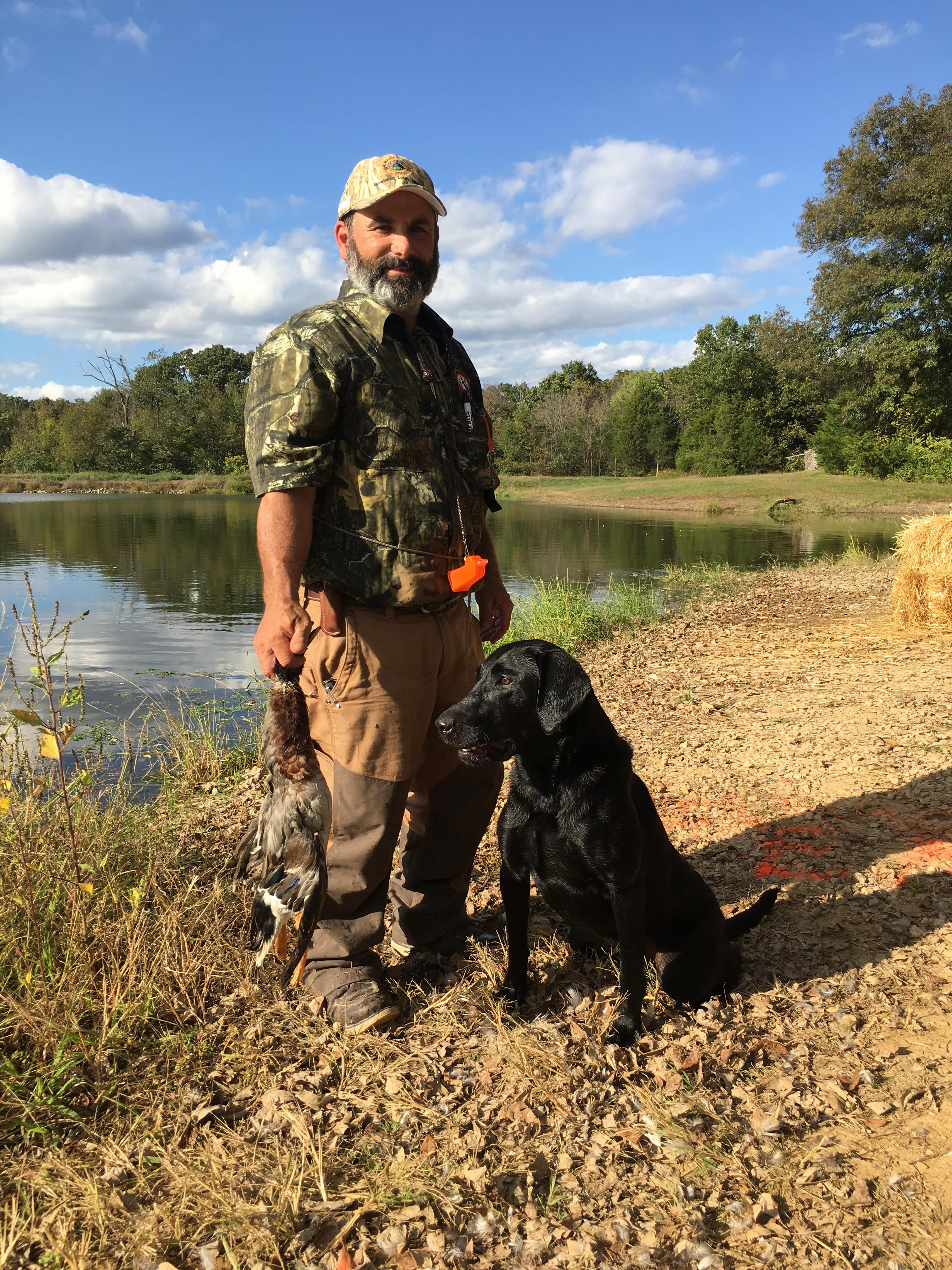
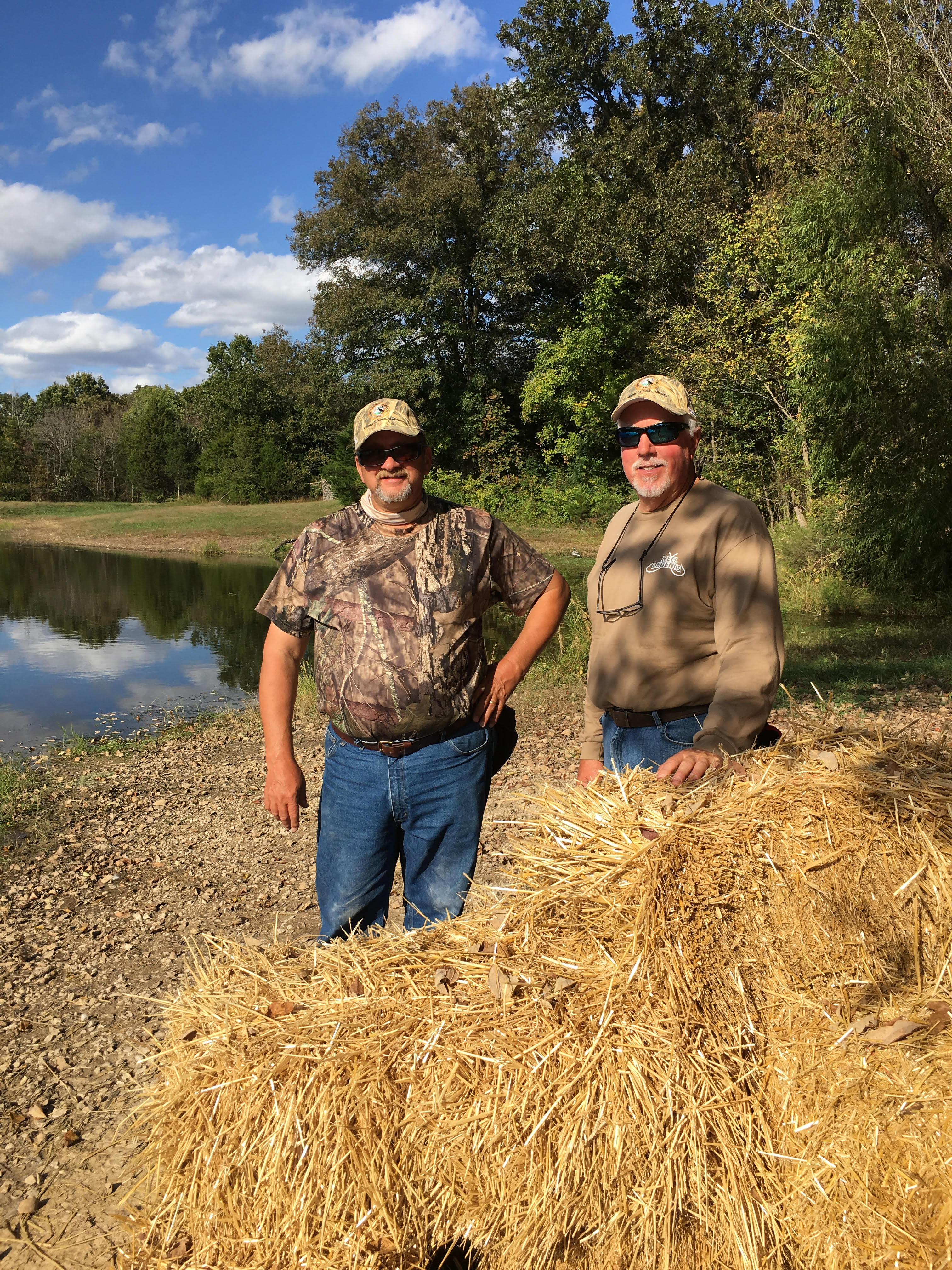
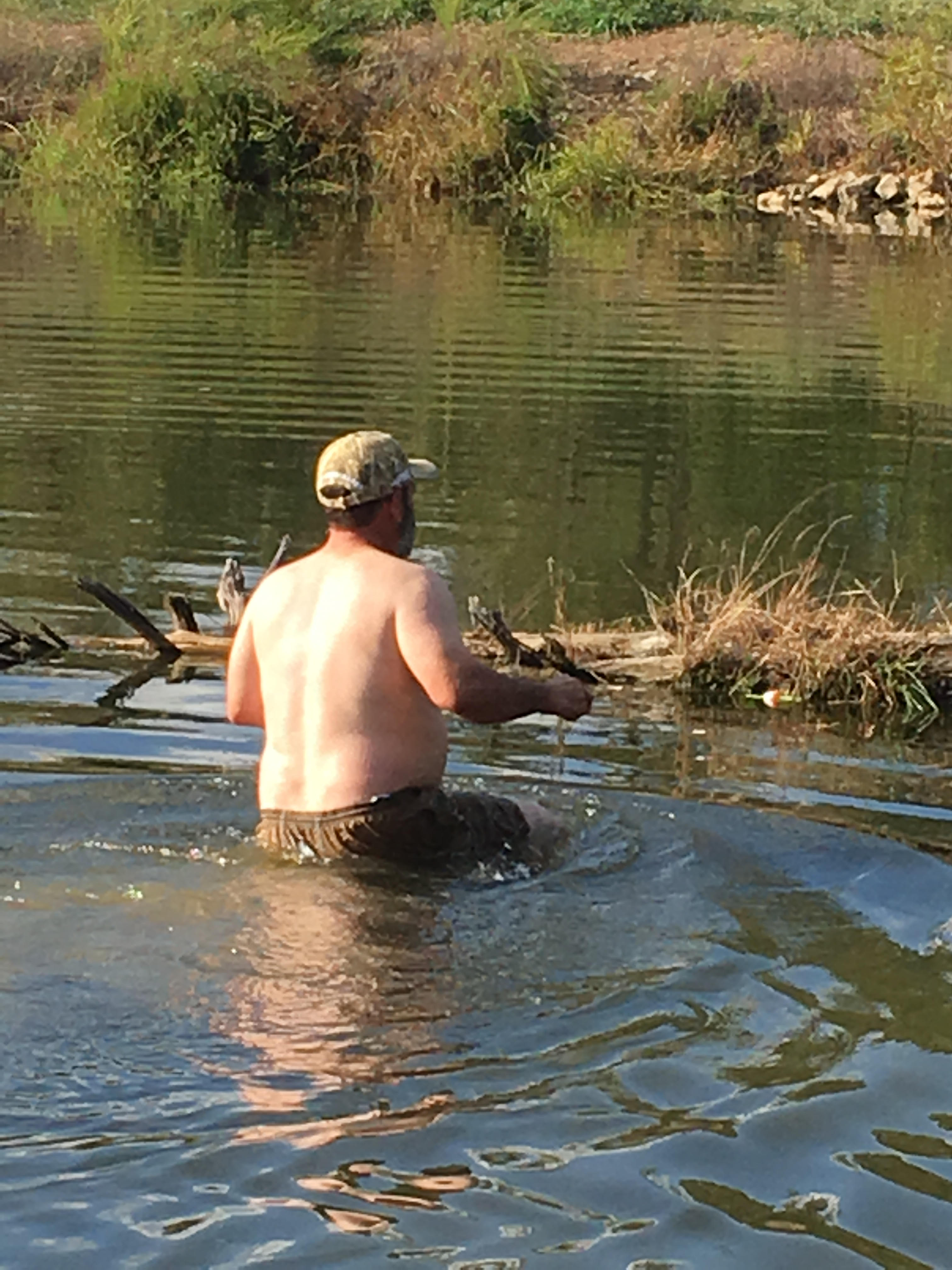
Wednesday afternoon Flight D handlers gathered on the shoreline of Lake 20, as Fred Collins and Ron Margiotta introduced our Fourth Series, a water series — affectionately nicknamed Wipeout Bobbers. The wind around the beautiful pond is gently swirling.
Seventy four retrievers will start the series with a remote send from a stack of hay bales. Judge Fred shocked all in attendance when he instructed handlers to place their dogs on top of the hay bales. He told handlers to heel their dogs up each step of the hay bales to the top. Before he admitted he was teasing, he even said older dogs could be assisted onto the hay bales. Only the judges thought this was funny…
Handlers will call for the first of three marks. Two (nearly in line) landmarks will be thrown across a small piece of water, and an especially inviting wipe out water mark will be thrown as the go bird. After collecting the marks, competing retrievers will run a shoreline, keyhole water blind. In this series, our judges would like to see control and for each dog to challenge the line to the blind
Brian Tucker and his new teammate Retta, a 4-year-old male, black Labrador, who just earned his Master Hunter Title, served as one of the test dogs for this series. This energetic retriever delighted handlers with flashy water entries and quick retrieves.
Brian earned extra credit points and delighted handlers when he swam out and collected fishing bobbers near the water blind corridor.
Flight E Missy Lemoi MNRC Reporter
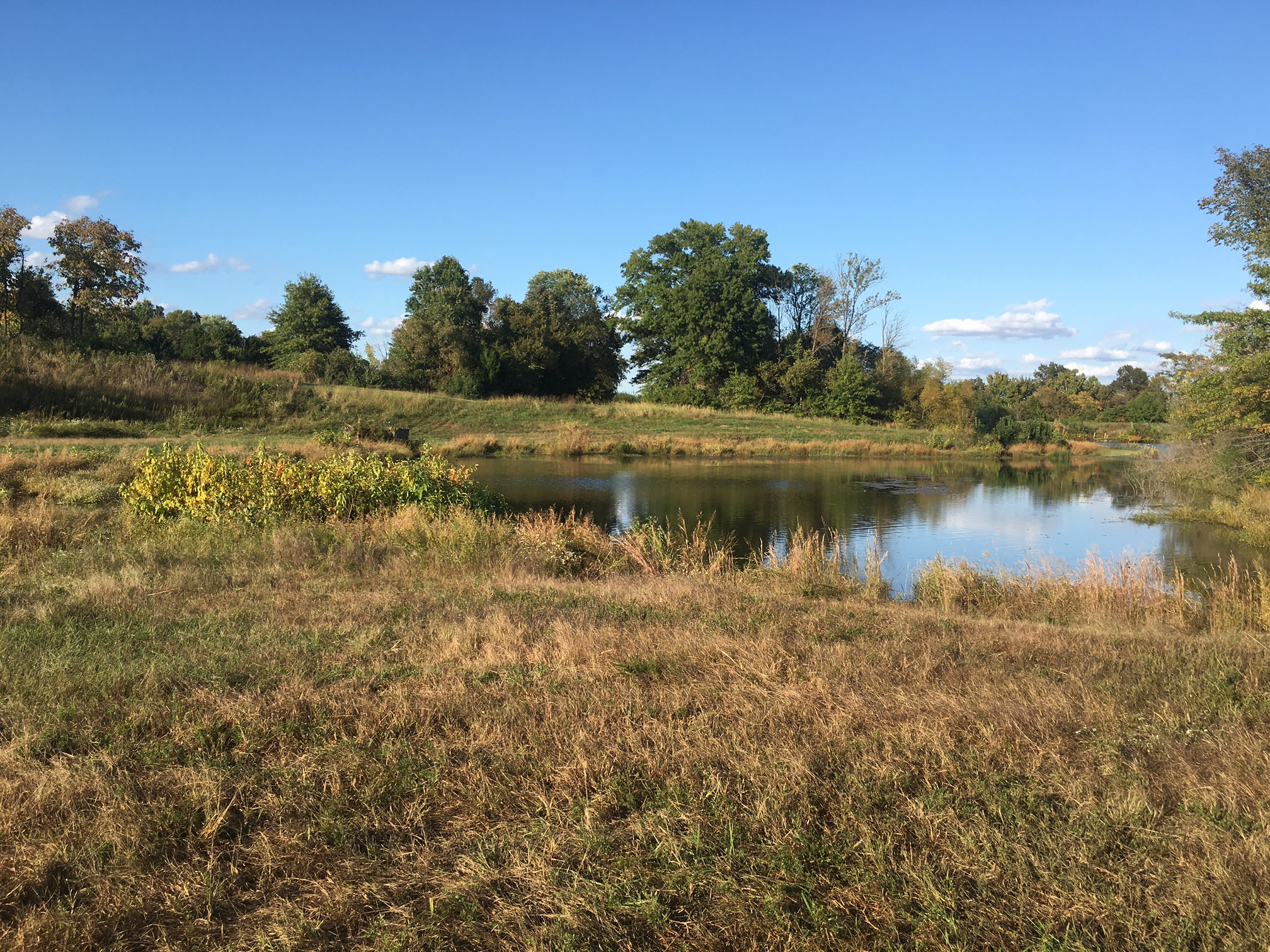
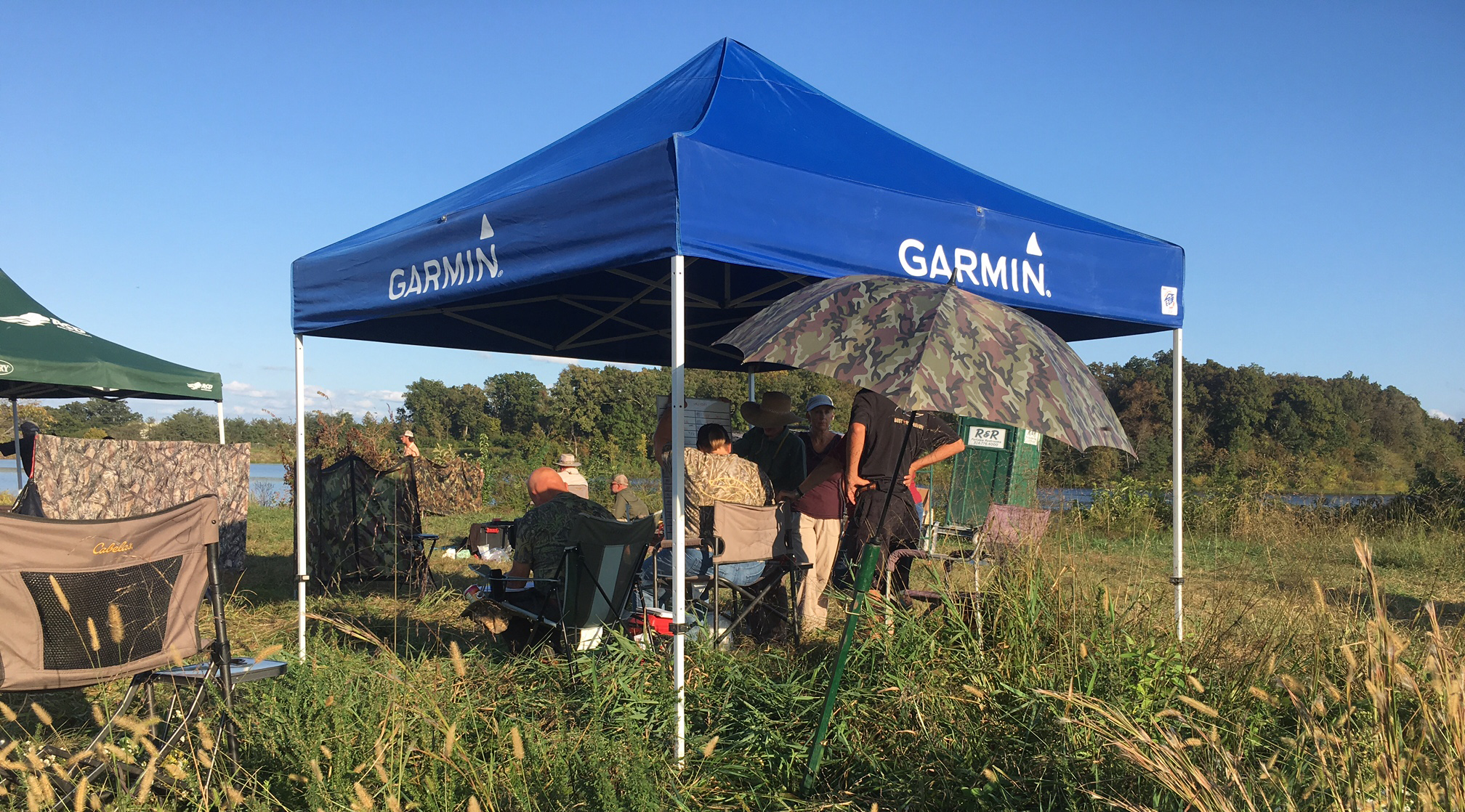
Day 4 started out cool and gloomy with a light shower as Flight E resumed its third series. The cloudy skies made the right bird harder for the dogs to mark. The really troublesome bird today has been the flyer. With the test straight down wind from the line and the variable fall areas, the dogs are having long hunts and can’t wind the bird when they get down wind of it. Even the go bird has been more difficult than during yesterday’s testing. Dogs have over run it, but most have recovered on their own.
Day 4 started out cool and gloomy with a light shower as Flight E resumed its third series. The cloudy skies made the right bird harder for the dogs to mark. The really troublesome bird today has been the flyer. With the test straight down wind from the line and the variable fall areas, the dogs are having long hunts and can’t wind the bird when they get down wind of it. Even the go bird has been more difficult than during yesterday’s testing. Dogs have over run it, but most have recovered on their own.
While the marks have become more difficult, the pathways to the blinds are very well established resulting in many dogs lining both blinds.
Flight E moved to its fourth series at Lake 35 at mid day today. The test is a remote sit at the corner of the pond. The handler blows a duck call to start the test. Station 1, at the far end of the pond, answers the call and throws a dead duck from left to right at the edge of the water. The second call comes from further left as a dead bird is launched from left to right in tall cover across a channel of water. The third bird is a bit of a surprise thrown into the water from behind the dog and handler landing about 25 yards in front of and to the right of the dog – assuming your dog is still sitting at the corner of the blind!
When the dog picks up the first bird down at the end of the pond, there is a diversion shot. After the marks are retrieved, the dog is sent for a shoreline blind that is hot whie the marks are being picked up. The line is through weeds in the water and between the shoreline and some dead bushes in the water, across a channel and up into a slot on the far shore.
There is a slight cross wind blowing across the handlers’ right shoulders. None of the dogs have broken on the splash bird, but several have gotten up as it lands. The test is set in a bowl. Dogs who do not mark the left and center birds well, run up the sides of the bowl to the rim and then work their way back down to the birds.
The blind is a tight corridor along the edge of the pond requiring lots of whistles to keep the dogs tight to, but not up on, the shoreline.
Flight F Alice Woodward MNRC Reporter
FINISHING THE THIRD SERIES AND A MEETING REPORT – WEDNESDAY MORNING
One test dog, “Lady,” handled by Lin, ran the test. Lady had not previously run this test. The first running dog, # 101, headed to the line at 7:44 a.m.
The rain predicted for this morning never materialized but a light morning drizzle was experienced. By 9 a.m. the sky was getting lighter, and at 9:33 a.m. Judge Christianson called for his sunglasses. From then on the day was sunny and bright, with temperatures rapidly climbing to an uncomfortable level.
The wind continued to blow in the dogs’ faces on this test, and was helpful to them in quickly locating the flier. Towards the end of the testing it shifted around to come from the right but still coming in as an onshore wind blowing into the handlers’ faces.
At 11:15 a.m. Flight F Chairman Larry Kimble halted the test for a brief meeting of all handlers and workers – who were called in from the field for it. Larry said similar meetings were being held at each of the other Flights. Larry reported on a meeting held by Master National officials and the Department of Conservation. The meeting was very cordial said Larry and the Conservation officials were very happy with how the Master National and the “dog people” were treating the grounds. There have been a few incidents of dog handlers driving out into fields to air however so do not do this and if you see any other handlers doing it please ask them not to. Also please do not air or exercise dogs in the two heavily used public fishing areas – please select somewhere else. The Department of Conservation provides a number to call if you see any after-hours inappropriate activity on the grounds. That is: 636-441-4554. Lastly the MN will be designating official Disabled parking areas at each stake.
The dog work on day 2 reflected a greater percentage of handles on the short bird than I observed on day 1 of this rest, and, sadly, several breaks. The several no-birds experienced on day 2 made for a good gig for pick-up dogs, since all birds landed in water. (However as this reporter understands, the Louisiana Duck Hunt is actually classified as Land-Water because it replaced a Land-Water series, being the one that was scrapped for safety concerns.)
Testing on the Louisiana Duck Hunt wrapped up at 1:20 p.m.and callbacks were give at 1:57 p.m. Flight F moved to its next venue to run its fourth series.
FOURTH SERIES STARTS AT THE “DOVE FIELD” – WEDNESDAY AFTERNOON
Flight F’s fourth series is a triple with a double blind and is set on the “Dove Field.” The hunting scenario is: “You are going dove hunting. The doves are really large ones.”
Judges’ Announcements.
By now the day had grown very warm and rather humid and the Dove Field is hot and dry. The judges explained that for safety reasons to prevent a dog from overheating on a long hunt, handlers “are requested to handle quickly if a dog leaves a fall area on his hunt.”
One handler asked if this meant that these handles would be “free handles.” After some deliberation on the implications of answering this question either way, the judges then advised that they would be telling the handlers when to put a hunting dog on the bird.
It was also announced that wading pools filled with cold water would be located where handlers could get their dogs wet both before and after running.
Lastly, it was announced that testing the next day would begin at 7:30 sharp so everyone should arrive by 7 a.m.
Test Description.
All birds are rooster pheasants. There is an out-of-order flier and an honor. It is a standing start (not a walk-up) and the handler calls for his first bird when ready.
As you face the field, there is a V-shaped grove of trees in front of you, point towards you, surrounded by dry cover varying from short to tall. There is also a tree-line behind you. The field rolls downwards away from you to the aforesaid grove of trees, and also rolls gently upwards on both sides of the grove, which lies in a swale. The marks will fall in the order: middle, left, right. There will be a diversion shot as the dog is returning with his second bird and a double blind is planted as he returns with his last bird.
Flier guns in a brushed-up blind on the right side of the grove in front of you shoot a flier left-to-right to sail out onto the hillside on the right of the tree grove. The flier is shot first and falls at about 150 yards. The next bird is a dead bird thrown right-to-left from a brushed-up blind on the left side of the grove of trees. This one appears to be a square throw.
It lands at about 95 yards and the bottom of a slight swale which invites dogs to overrun it and climb the hill beyond. The third bird is thrown right-to-left from a brushed up-blind on the handler’s right nestled along the tree line behind the handler. This bird falls at about 80 yards. Calls from some game bird species precede each throw.
The line to one blind is under the arc of fall number two and the line to it angles toward the tree line where this blind planter is hiding. This blind is about 150 yards. The other blind is off to the left of all the marks, the line to it climbing a gentle rise. The distance to this blind is about 105 yards, and it is placed just short of where a dog will go out of sight over the rise if he gets deep of the blind! A prominent holding blind covered with a grass mat conceals the planter for this blind and it is almost directly beyond the blind. Both blinds are marked with orange stakes. The handler can pick up the blinds in either order.
Wind varies during testing from no wind (never good news for the dog running at that time!) to a light cross wind usually from the right.
Test Dogs. The first test dog, “Cher” handled by Lin Gelbmann, made quick work of the test with two pinned marks and an efficient hunt on the flier. Cher’s initial line on both blinds was a bit to the right (as would be the case with many of the competing dogs – perhaps due to the location of the gunning stations and way the hillside falls away?) but Cher had no problems with either blind. The second test dog, “Babe” handled by Corinne Clavey, totally slaughtered the test with three pinned marks and two solid blinds. The second test dog completed at 3:46 p.m.
Dog Work on the Dove Hunt
Dog # 71 was the first running dog and came to the line at 3:55 p.m.
As the work proceeded on this series it quickly became evident that the test dogs’ “Nuthin’ to it Mom” runs had made the test look deceptively easy. Both memory birds gave teams trouble in about equal measure.
There were a number of handles on the left-hand bird as dogs over ran it and had loose hunts. In this case they could work towards the distraction of the blind planter’s holding blind to the left and up on the hillside, especially when it was illuminated in the sunlight and dogs could spot it from a distance.
The rooster flier proved to be the challenge that these fliers tend to be – with greatly varying falls. Birds that flew well could land well up on the hillside – a long way from the gunning station. This is a place it is mentally difficult for dogs to want to remain in long enough to hunt up the bird when the trees and the gunning station offer attractive alternatives. Trails also formed in the line of cover that crosses the to the flier fall area. Taking one of these trails could push a dog off the line to its own bird and make for a hunt.
Most teams picked up the flier last.
The blinds did not give most teams trouble but whistles were needed and they were not slam dunks. Most teams (all, as far as I could tell on Wednesday) picked up the blinds in the same order: left then right.
End of the Day on Wednesday
Testing concluded fairly early, at 5:37 p.m. because the lengthening shadows from the grove of trees made visibility of the flier fall difficult. Dog # 94 was the last to run, leaving a little over 60 dogs for testing the next day. This test was running about 8 dogs an hour on Wednesday.
Tuesday, October 4, 2016
Flight A Jack Combs MNRC Reporter
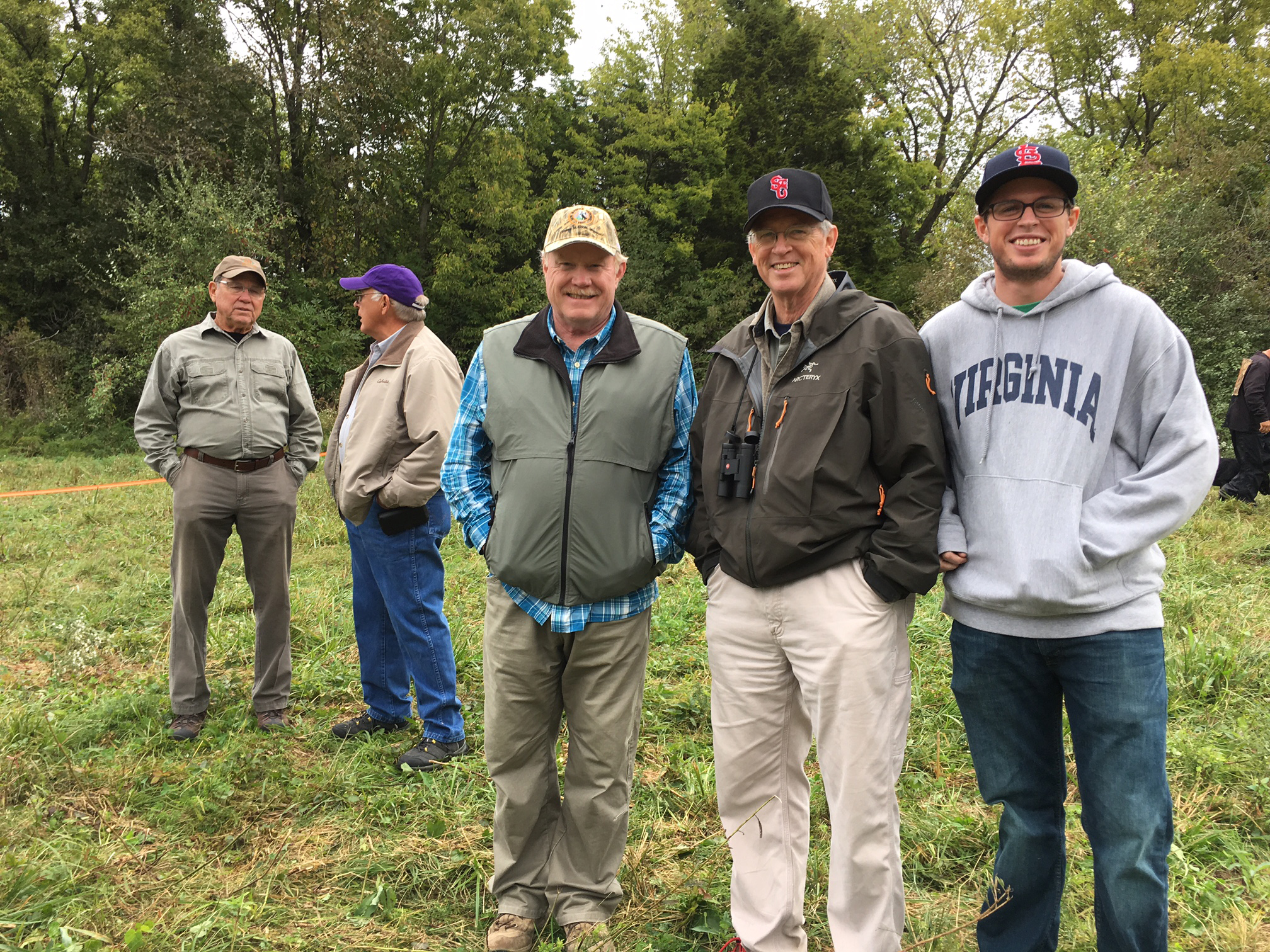
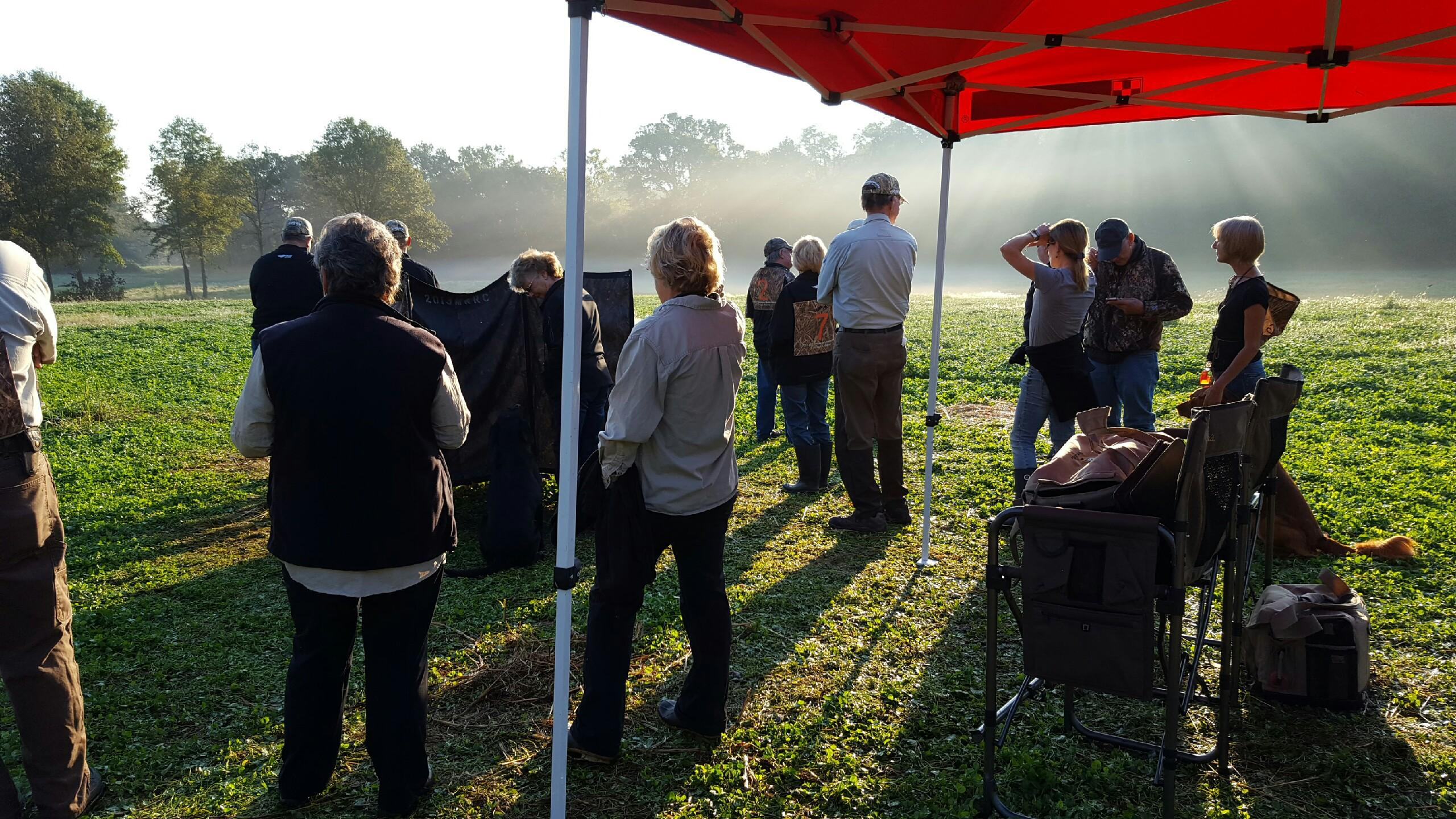

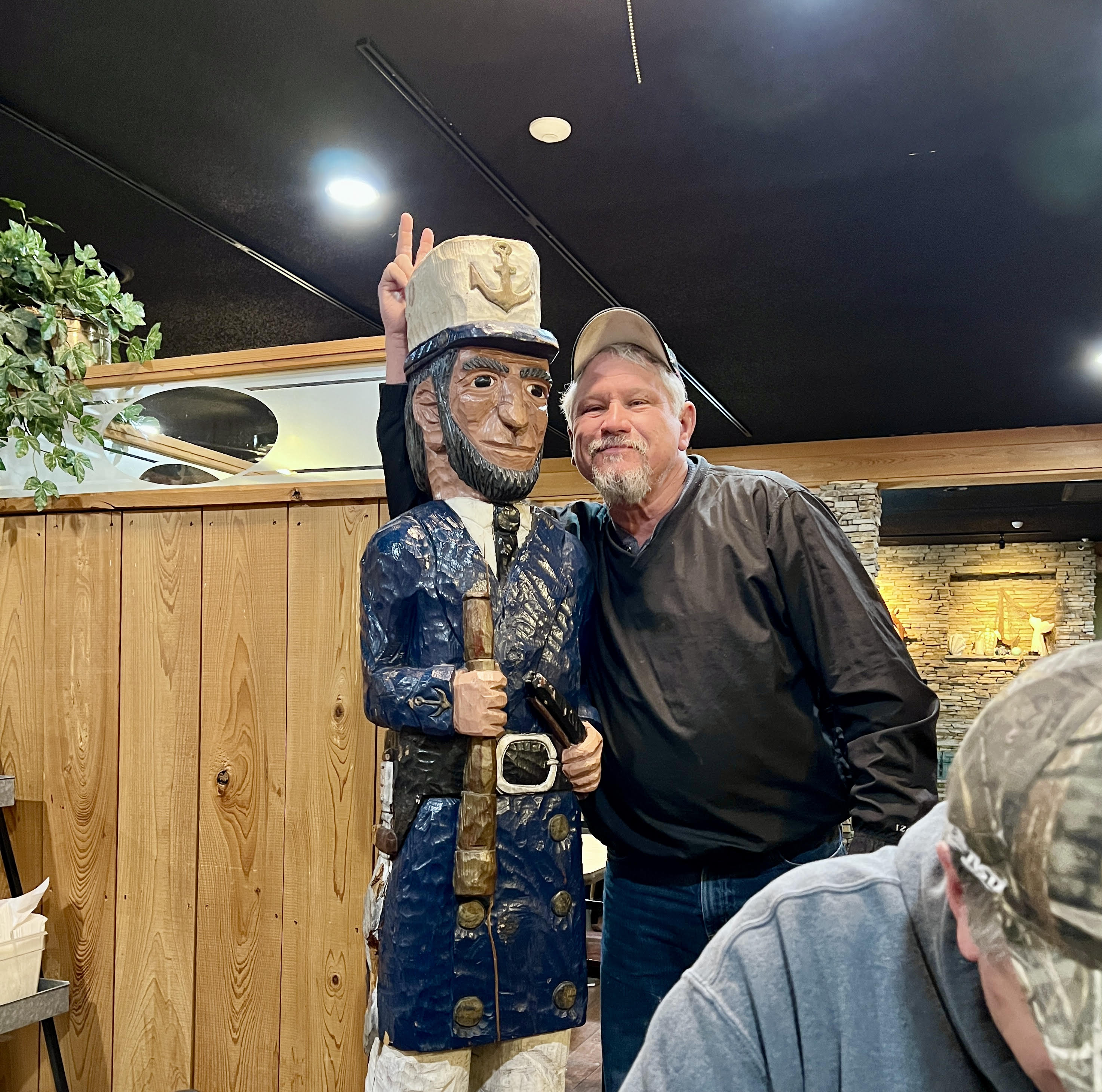
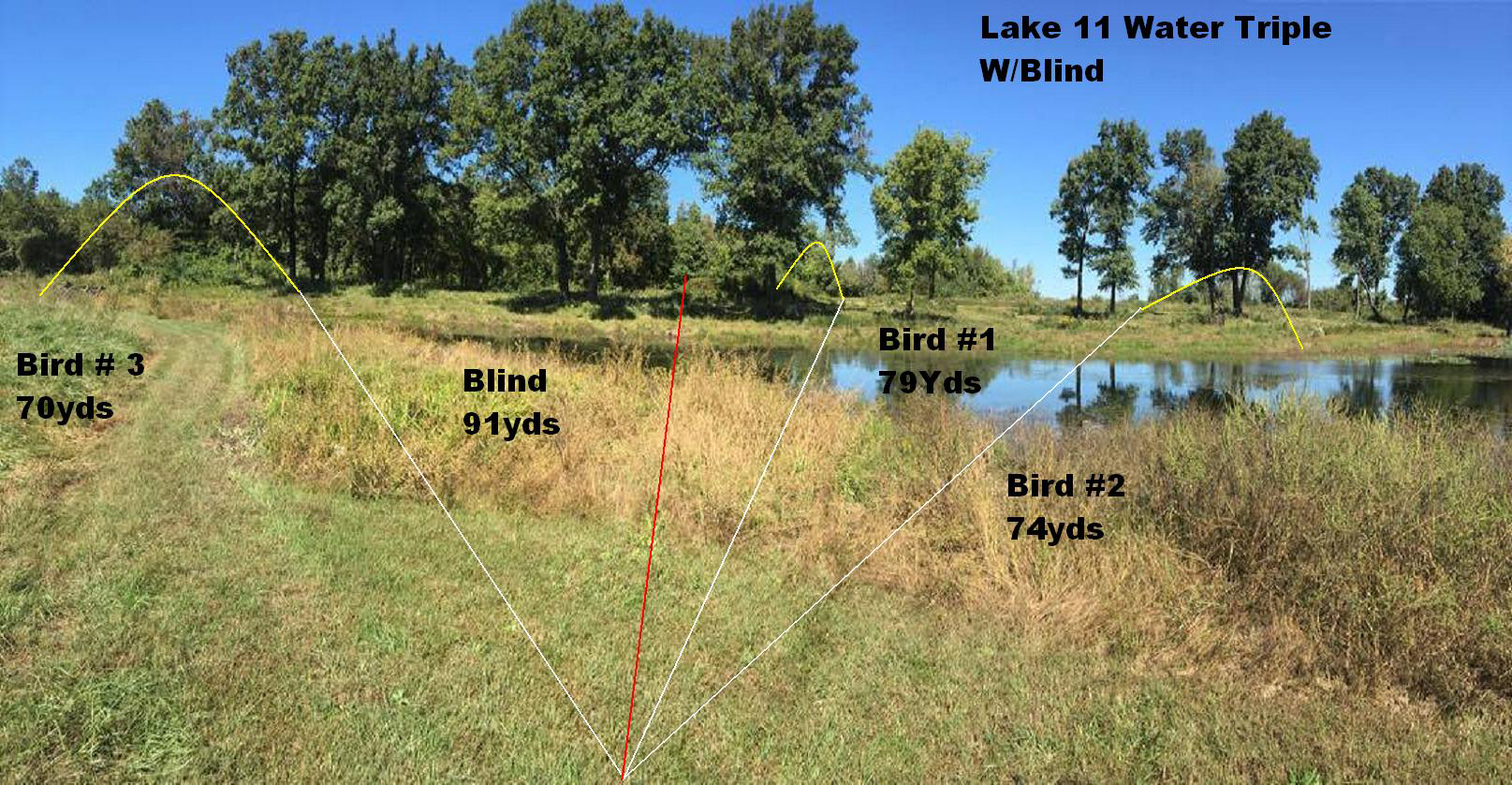
Lake 11 was a water triple with blind and diversion shot. The test begins with a remote sit of the dog in front of the last holding blind. Bird #1 is thrown slightly to the left of the handler, angled back to the right and lands 79 yards away.
Bird #2 is to the right and lands 74 yards away. Bird #3 is to the extreme left of the handler and lands 70 yards away. There is a diversion shot when bird #1 is retrieved. The blind is 91 yards directly across from the handler.
We are the second flight to run Lake 11, a water triple with a remote set and water blind. The first ran ran 141 dogs over this test and as a result there are paths in the near shore vegetation, some good and some not splitting marks 1 and 2.
This afternoon the wind picked up and backed to the southwest affecting all three marks.
Many handlers are forced to handle on the go bird then pick up two difficult marks.
Flight B Melissa Robinson Shanks MNRC Reporter
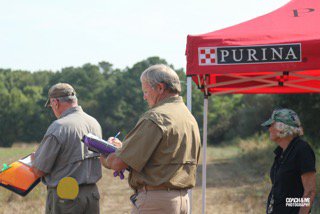
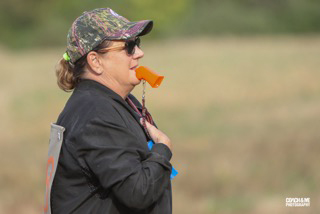 Flight B finished its second series around 11:30. One hundred dogs were called back to the third series, which is at Lake #30. Once again, a great crew made quick work of setting up for the new series (only delayed by Sam needing to finish a joke–which will NOT be repeated here).
Flight B finished its second series around 11:30. One hundred dogs were called back to the third series, which is at Lake #30. Once again, a great crew made quick work of setting up for the new series (only delayed by Sam needing to finish a joke–which will NOT be repeated here).
The third series is a water triple with a remote sit and a single blind. The first mark (left hand mark) is across the end of the pond, L to R, mark lands on the bank–very cheaty line to the mark. Judges suggested that dogs should get wet…. Second mark (right hand) is on land (L to R). Go bird is the center mark, right to left out into the pond. Blind is under the arc of the go bird, very tight to the right hand shore, out to a point. Lots of suction…. Flight E recently did this same test.
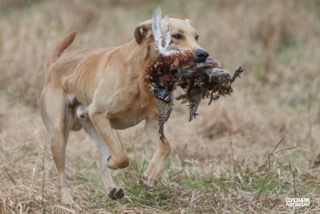
There was a nice afternoon breeze. Musical accompaniment was provided by the high school marching band practice, which could be heard from across Highway D.
The test finished up for the evening about 5:30 pm. We’ll continue in the morning, with #111 going to the line at 7am.
-Julie Luther
Flight C Frank Barton MNRC Reporter
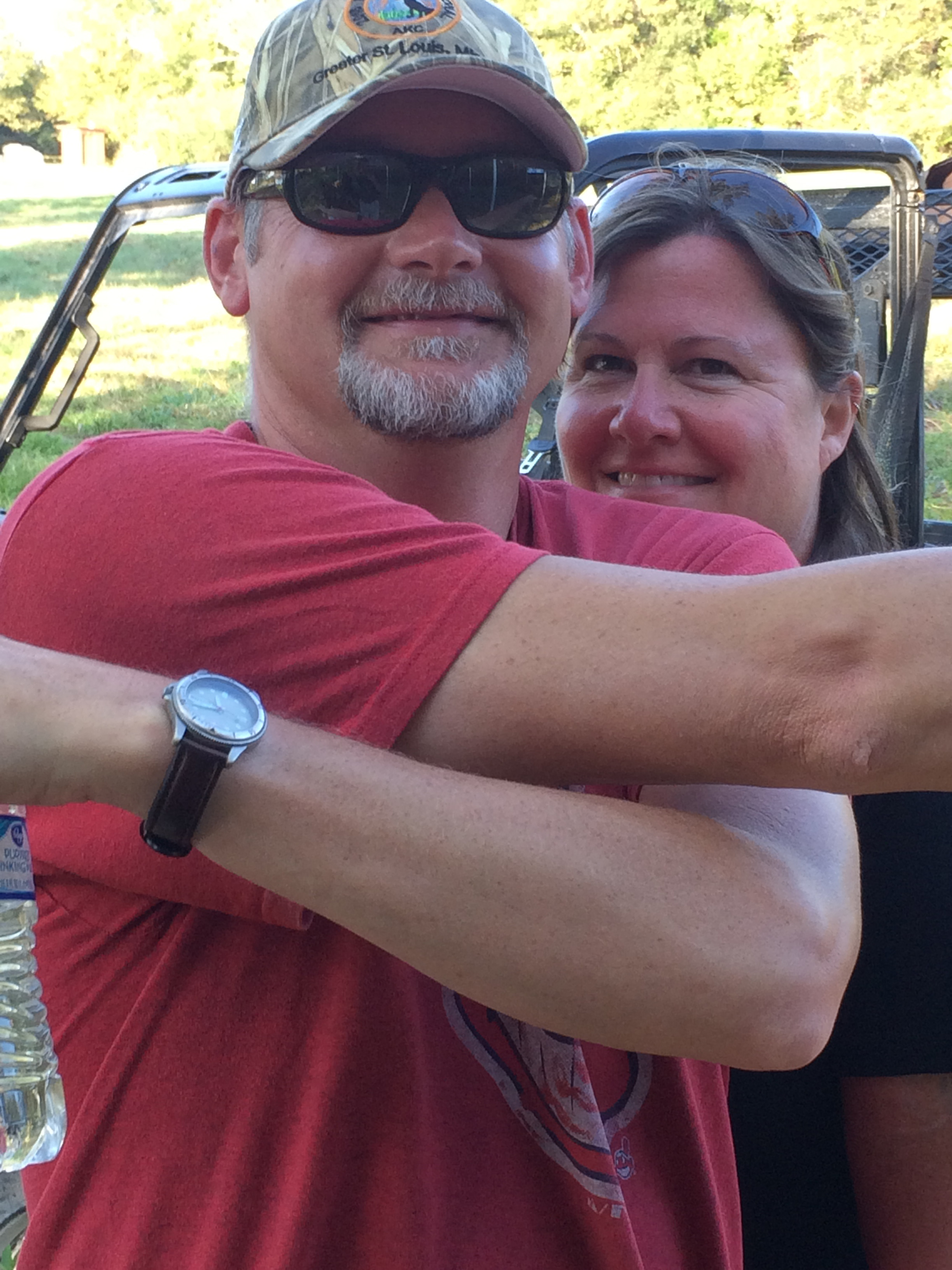
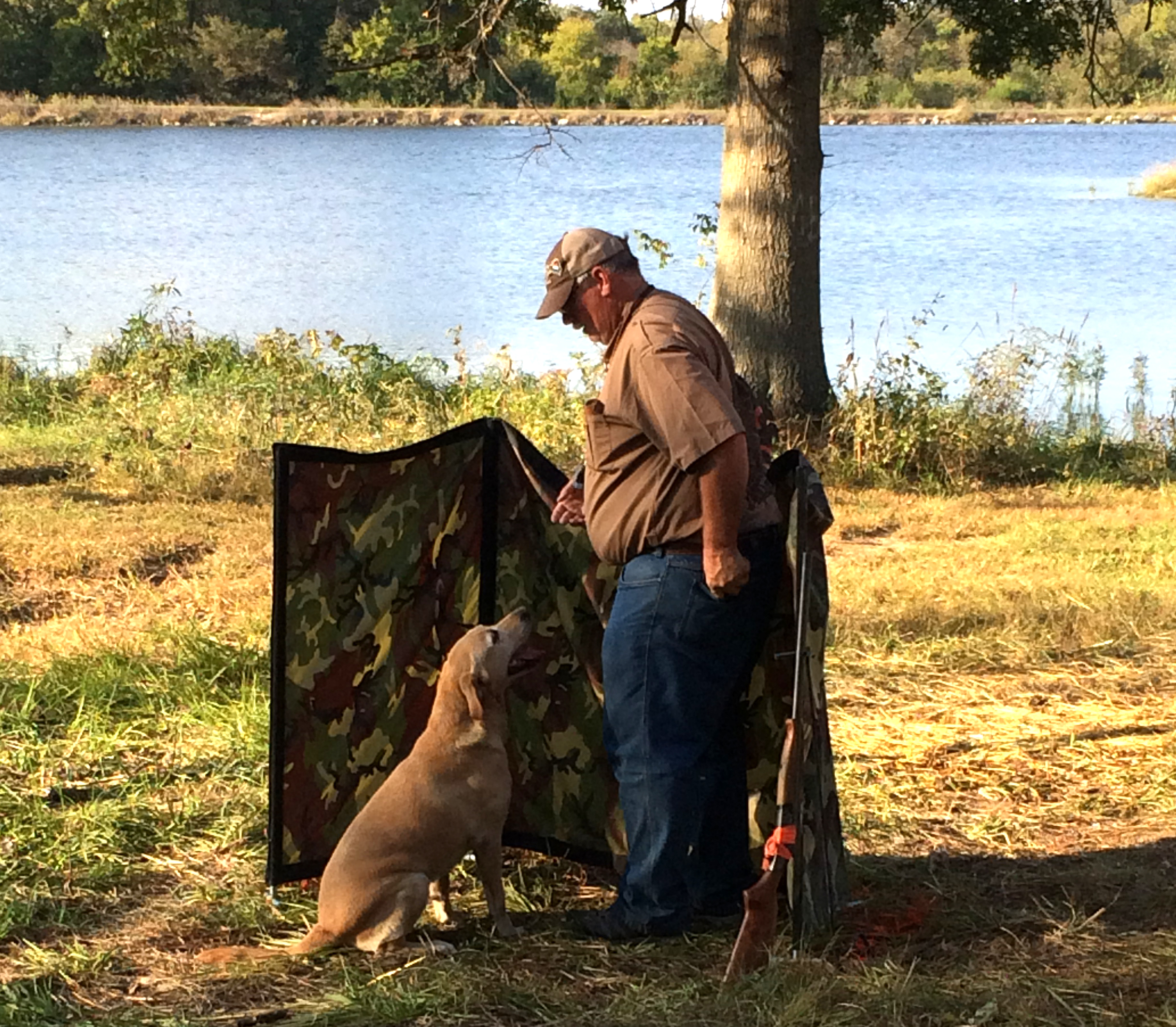
Flight C continued Tuesday morning with their test at Lake 35. The day did not start well as the first dog handled, the second dog broke on the splash bird, and the third dog handled. The down the shore blind continued to be a problem for many dogs this test. and speculation from the gallery dominated the morning discussions as to how judges Alan Bruhin and Laura Judd would score.
As the day progressed the work on the mark improved, but the blind still ruled the test. Flight C concluded its water test at this site at 1:50PM.
Stake Marshall Allan Dillard announced that we would caravan from the parking area to the new test site at Lake 21 in order to cause minimal disruption to the D Flight that was now running at the adjacent Triangle Field test. Flight D coordinated their shift change and re-bird with Flight C and the move went as expected and caused no delay in D Flight’s testing.
At 3:30 Flight C was running test dogs at the Lake 21 test. As the working dogs started filtering thru the holding blinds and ran the test, it became clear that this test would no prove to a significant challenge to the current crop of C flight dogs. This test had already been run as an opening series for the A flight. The surprising bird that caused problems was the splashed and sluiced flyer. The bird placement on the opposite side of a patch of lily pads created surprising results. Many dogs started to swim thru the vegetation only to break down and beach early behind the flyer station. As a results, several handles were observed.
To be continued…….
Flight D Dorothy Ruehman MNRC Reporter
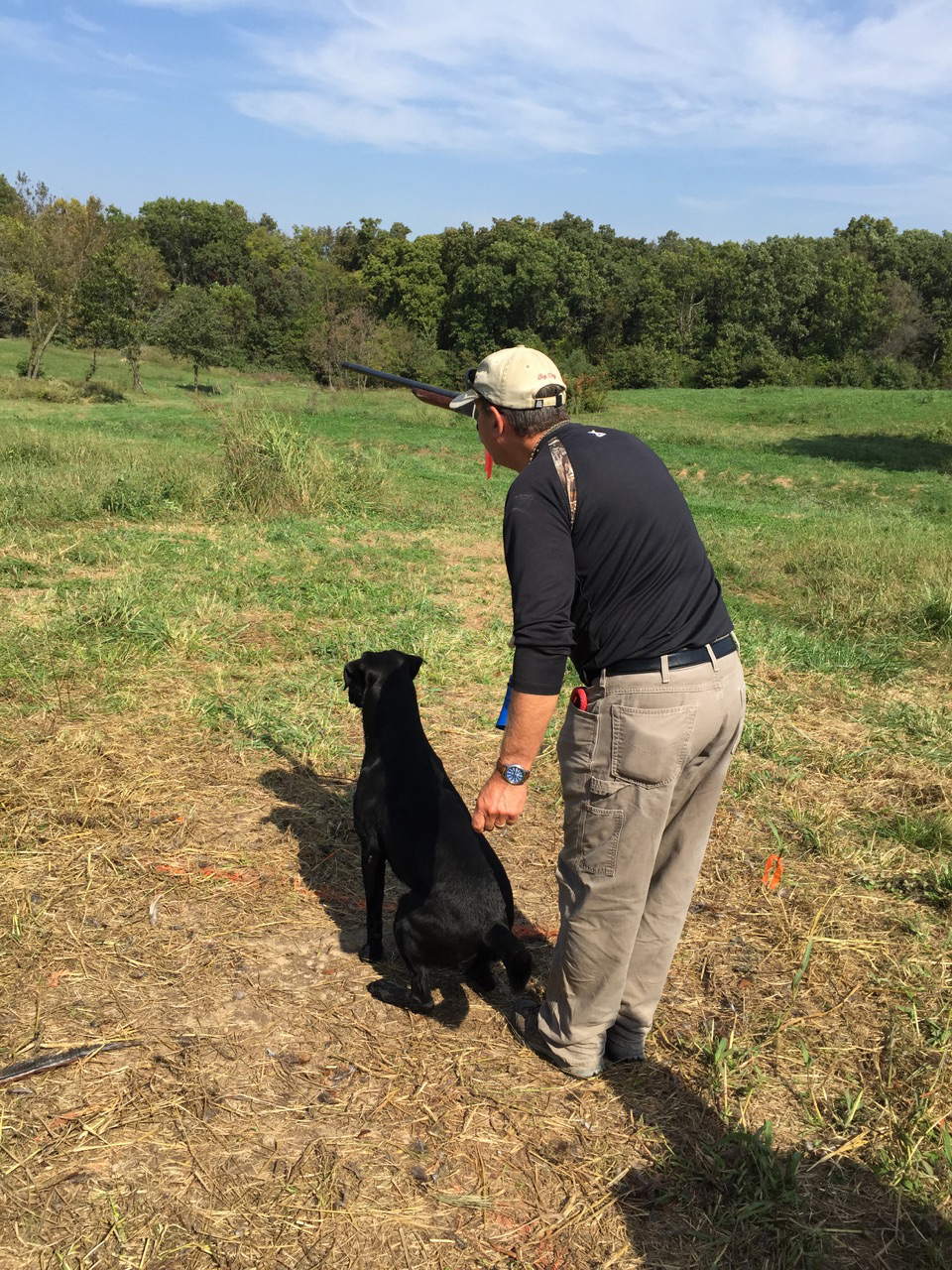
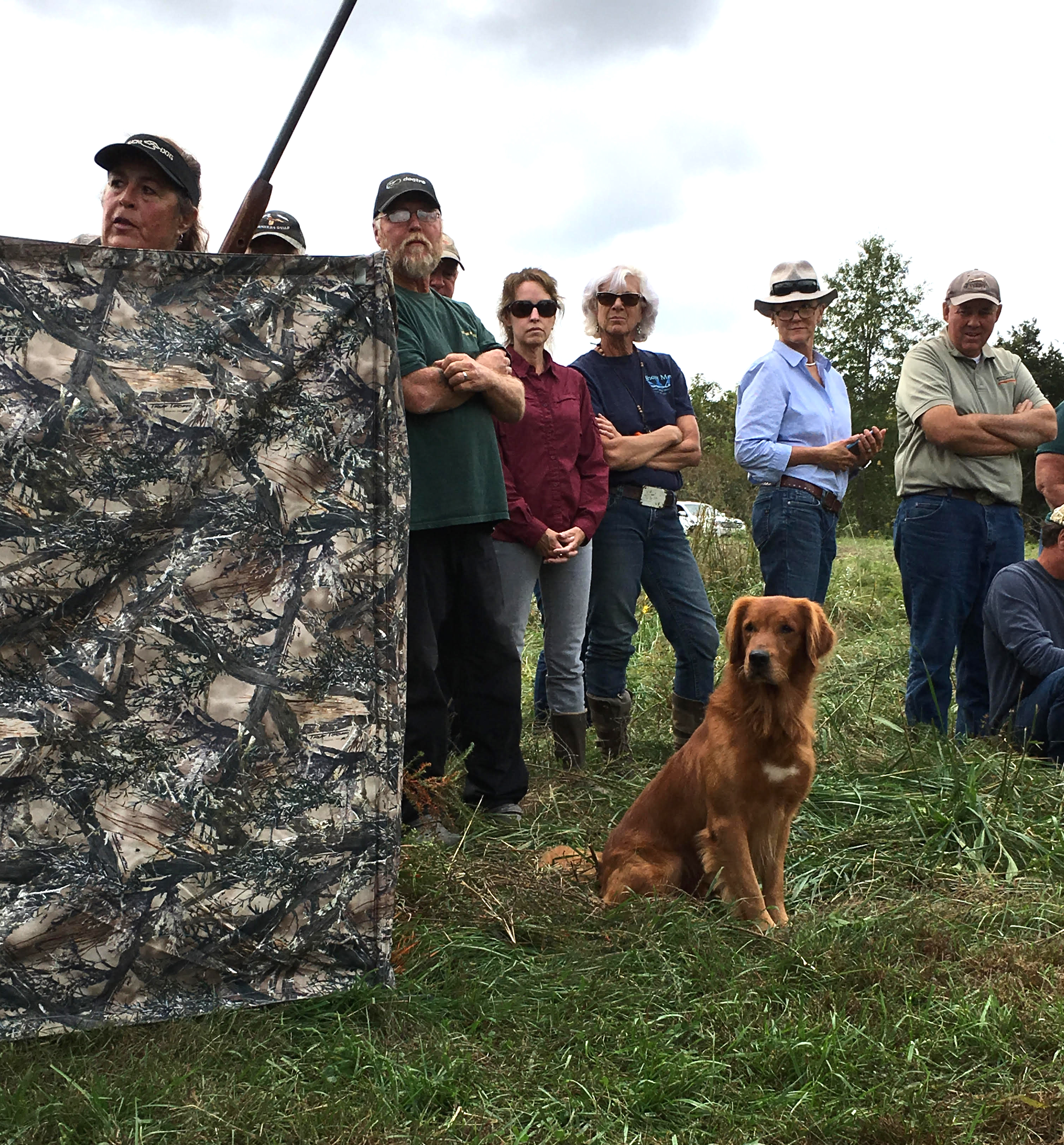
Flight D is hosting Tuesday’s lunchtime and Third Series in Triangle Field, more appropriately renamed “Agony Valley” by handlers. The toasty temperature makes a few of us feel right at home, and allergens are abundant – just ask the sneezing gallery. Somehow our pesty insect specimens followed us to our new location. Still itching from some…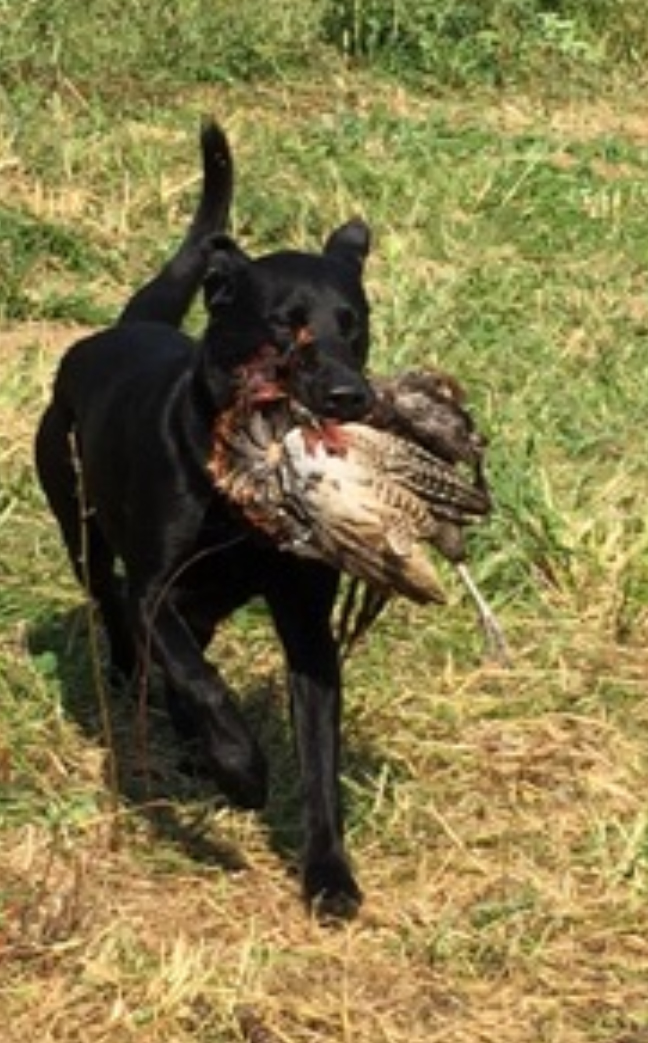
The test site is nestled in a picturesque hay field valley with interesting contour. This site offers competing retrievers and their handlers a pheasant hunt with triple marks, a diversion bird and double blind. A strengthening south wind won’t help much with the marks.
The marks are thrown from well-brushed blinds around the horn from right to left – starting with a live flyer, thrown left to right and landing upon a hill; followed by a middle bird launched right to left settling on a hill in front; and the left and third bird pinched inward from right to left, landing in a low spot in the field.
When returning with the last mark, a diversion bird will be thrown from far left. Retrievers must run their left blind first, and then handlers may decide whether or not to pick up the diversion bird or second blind next.
The gallery was treated to an exceptional Test Dog run by team mates Mark Ottis and his 3-year-old, black male Labrador – Fly. Fly pinned all three marks, ran solid blinds and collected his diversion bird. With only two master passes to his name, this QAA youngster is one to watch!
Ghosted by: Ruby Ruehman
Flight E Missy Lemoi MNRC Reporter
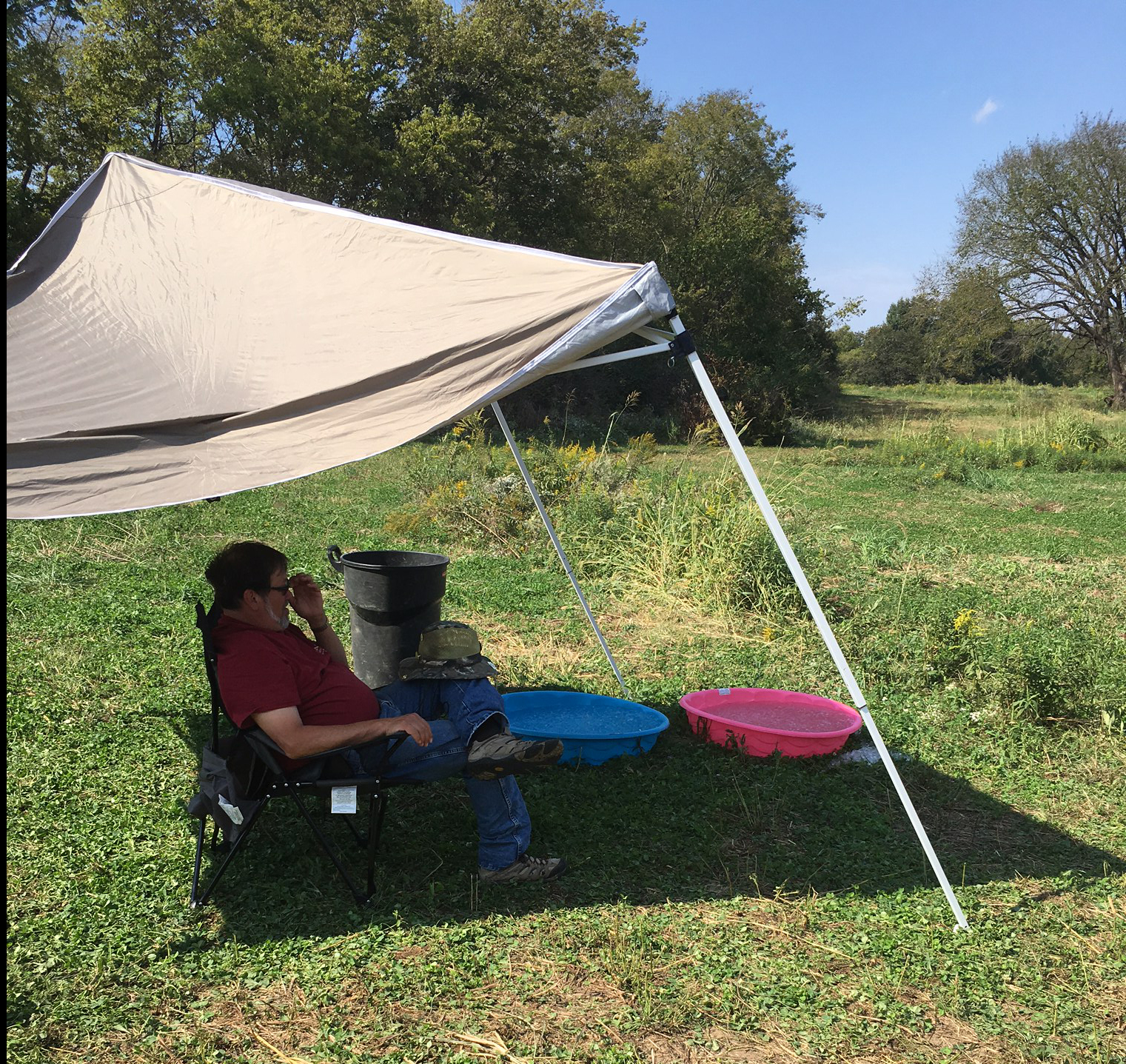
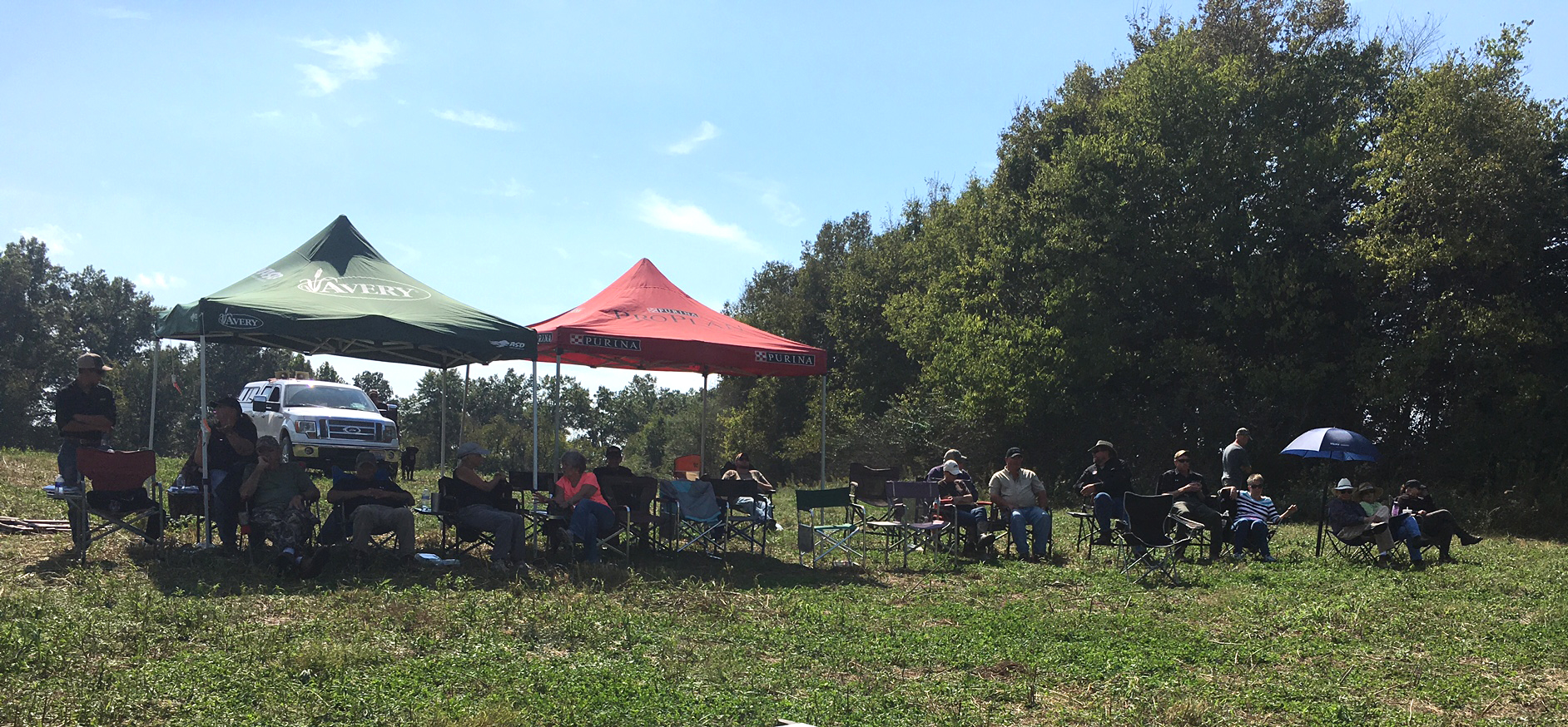
Flight E’s third series is a pheasant triple with a diversion bird, a double blind and an honor. We are running in the field where Flight F started. Handlers bring their dogs to the line and signal when they are ready. The first bird down is thrown from right to left from behind a point of cover. The second bird is a long flyer shot right to left usually landing in a cut strip behind heavy cover. The third bird is a short throw from left to right on the left side of the test.
As the dog returns with its third mark, a diversion bird is thrown along cover on the right edge of the test. The diversion bird becomes a poison bird as the dog has to run a short blind past it and under the arc of the first bird thrown. The handler has a choice of picking up the diversion bird after the short blind, or running the long blind to the left and then picking up the diversion bird.
The dogs who ran early did the test well, and with few whistles. As the grass dried and the temperatures rose, the dogs seemed to be having more trouble navigating the heavy patches of cover that threw them off line for the marks and the blinds. In spite of some creative lines, the dogs were getting to the marks and no one seemed to have a major problem with the blinds. The diversion/poison bird, while tempting, did not create any problems for the dogs.
The bright sunlight lit the field and all marks were clearly visible. The wind changed direction from blowing at the handlers’ backs to a crosswind blowing right to left across the test. With the warmer temperatures today, the committee was ready with pools of cold water to help any dogs who needed to cool off after their runs.
Flight F Alice Woodward MNRC Reporter
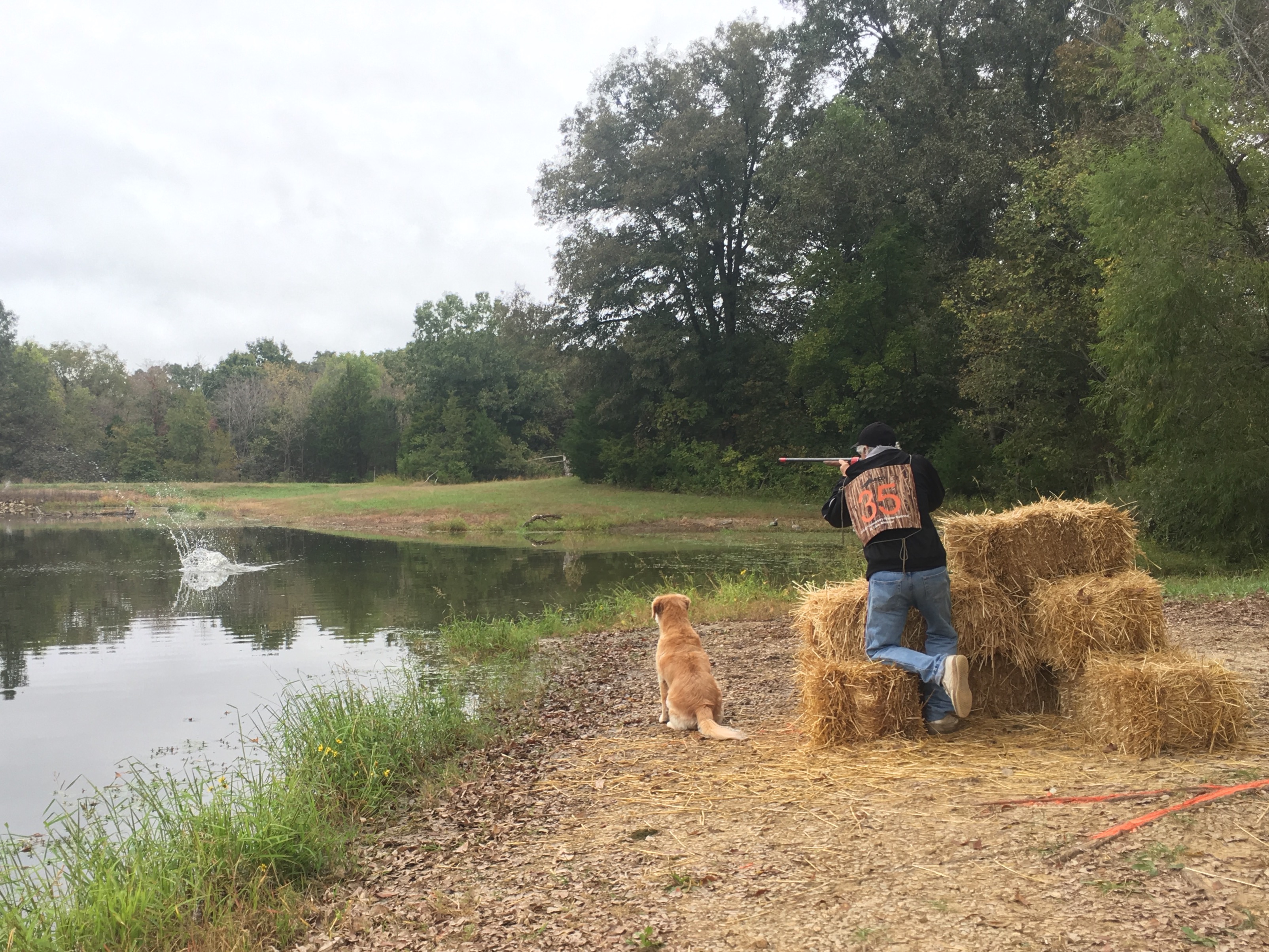
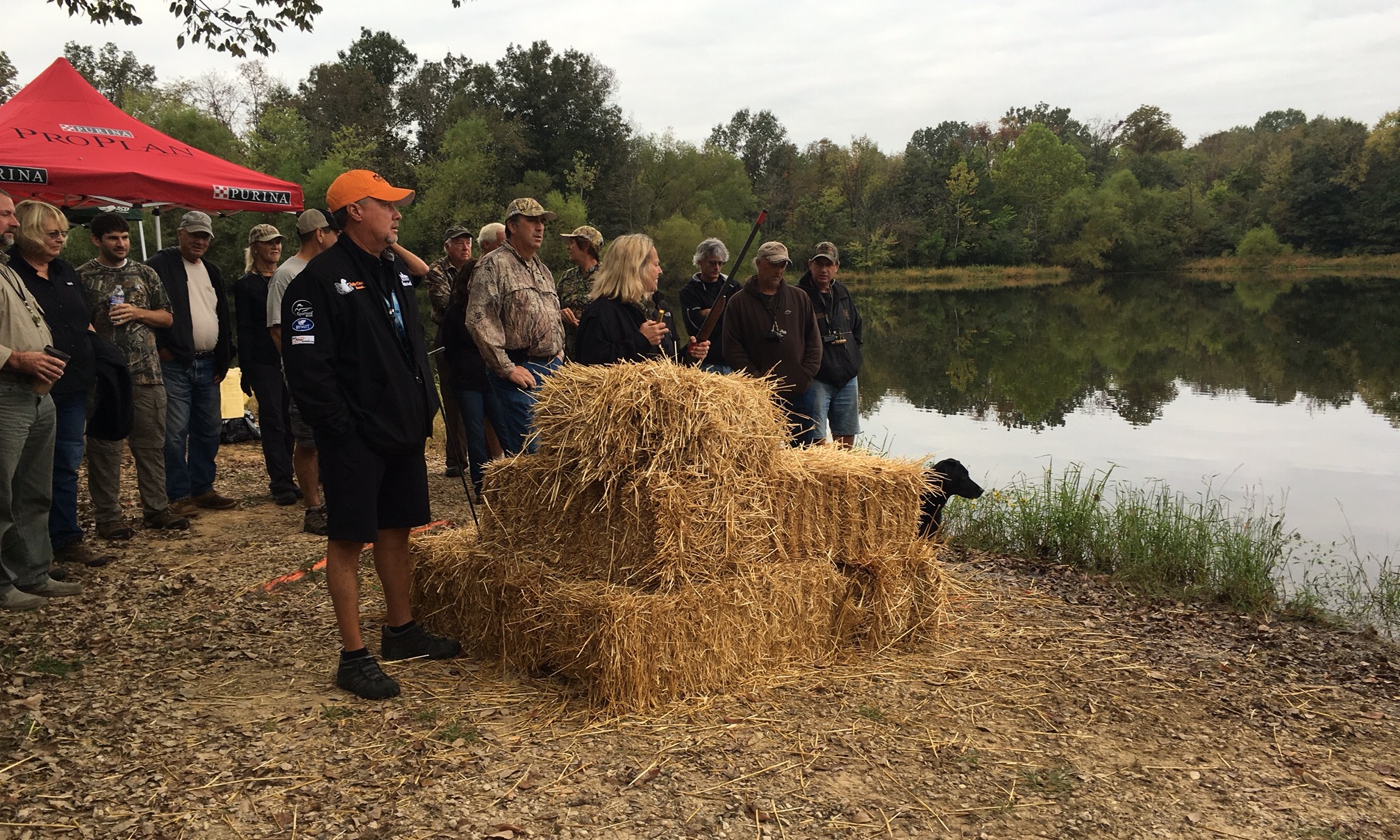
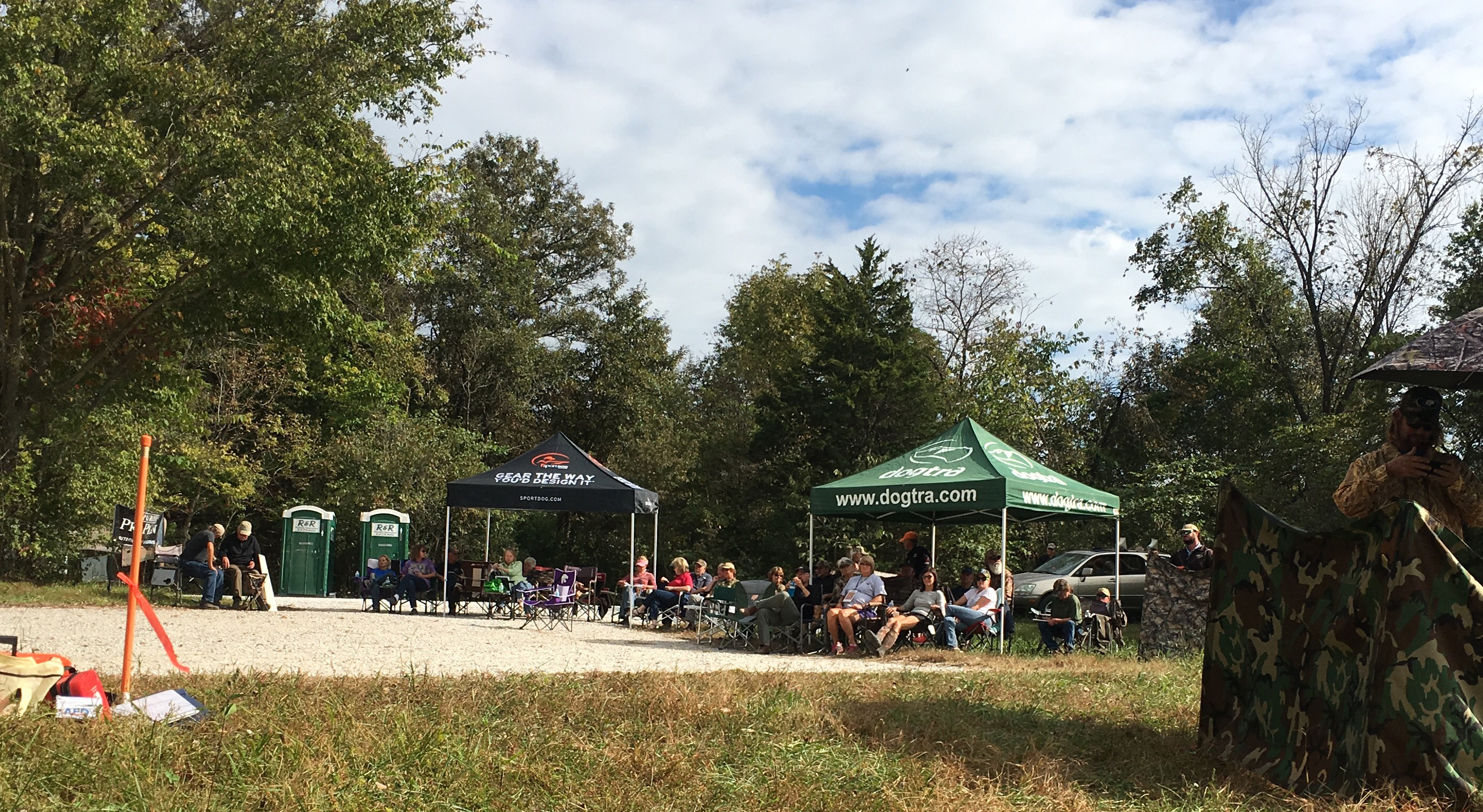
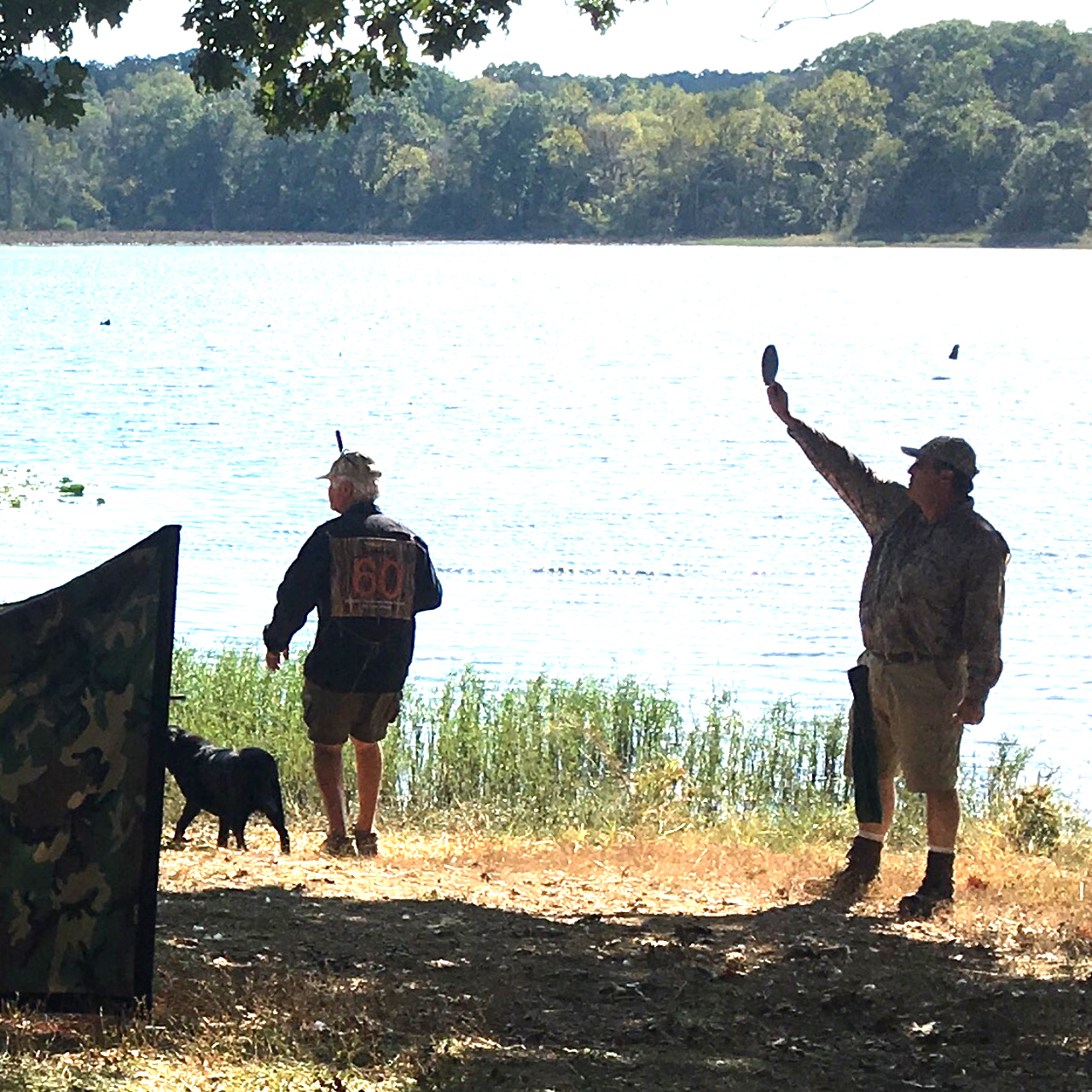
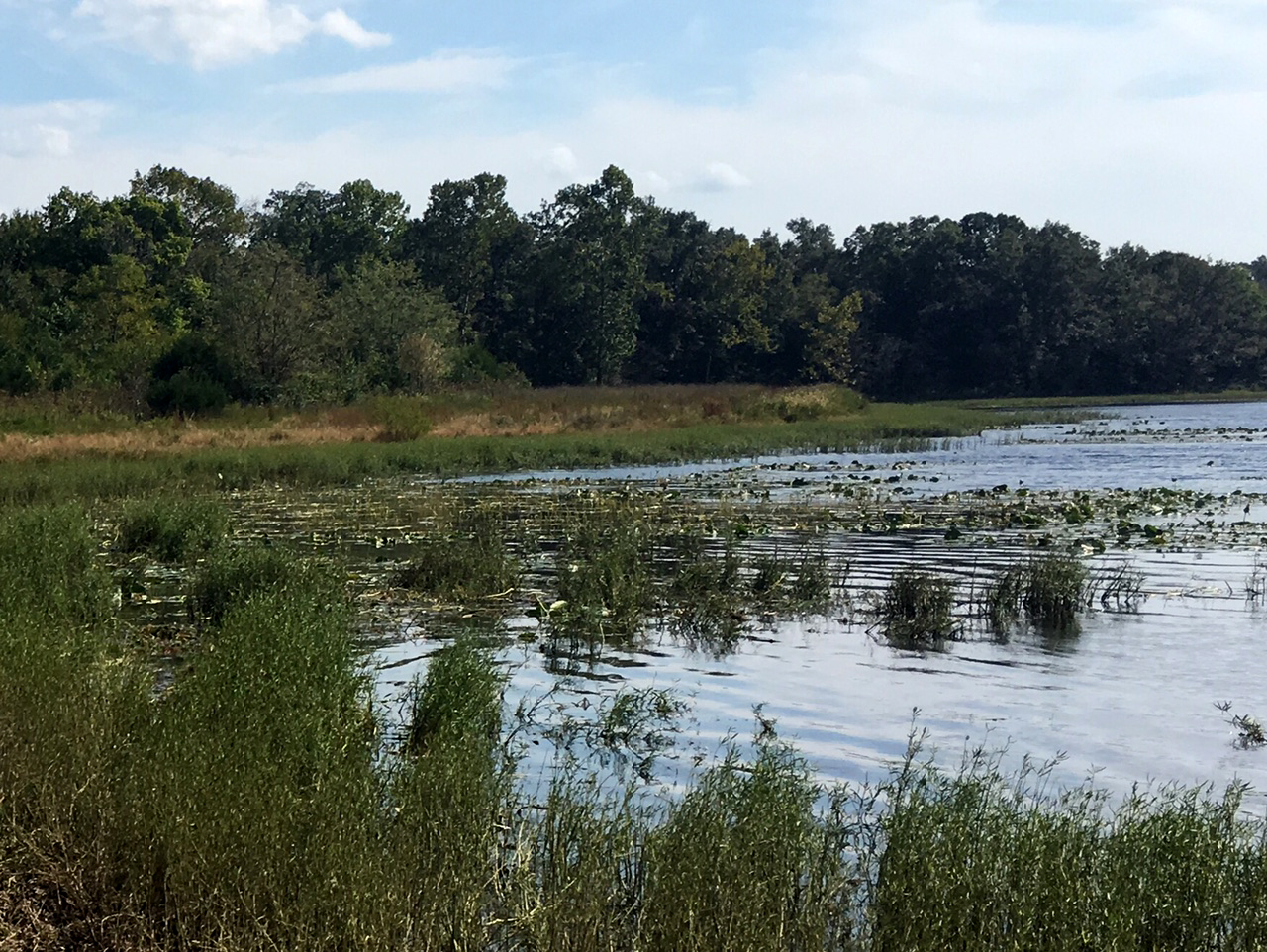
Testing on the second series of Flight F concluded at 12:26 p.m. on Tuesday. The weather on Tuesday morning has turned sunny but is also fairly humid.
The light on the test at Lake 20 is better this morning than yesterday, which was overcast. But ironically the better light has made one factor more difficult for the dogs because sunlight on the submerged log out in the pond has made this “decoy destination” easier for dogs to spot from a distance.
The testing of Flight F contenders now moves to Lake 37. This new test was arranged after the other tests had already been designed — when safety concerns resulted in scrapping a test that had been designed at Lake 38.
Call backs have been given at 1:15 p.m. at the new test site. 90 dogs back.
Flight F’s 3rd Series is a water triple set on the same edge of a pond as is the line. All birds fall in water. A walk-up bird on the left thrown at 20 yards into cover on the pond edge starts the test. An out-of-order flier, also on the left and beyond the walk-up bird, is shot second at 90 yards and arcs out into the pond to land in water filled with light lily pad cover. This is followed by a swing of 180 degrees to the last bird down which is an “in” throw at 38 yards and lands in open water. All birds are thrown by wingers from well brushed up holding blinds. The wind was fairly strong and blowing towards the shore (hence more or less into the handlers’ face) and swung between a straight-in head wind and a wind quartering from the left. It was a sunny afternoon with the sun coming off the water and giving good visibility for the floating birds.
The judges gave the hunting scenario. It is a Louisiana duck hunt and you are hunting with your hunting buddies Thibedeaux, Budreaux, and Leroy. You are late (again . . .) and your buddies are already in their blinds when you arrive. You have forgotten your gun (actually it is broken but you are going to shoulder it anyway) but your buddies have even forgotten their dogs! So once again you have the only dog on this duck hunt. As you you walk towards the pond with your dog at heel here come some birds. Budreaux (who has also forgotten his duck call it seems) drops a close one on your left, Thibedeaux hiding farther along the same shoreline on your left shoots one that arcs out into the lily pads, and then suddenly Leroy over on your far right who has build his blind right next to three shiny Jon boats pulled up on shore manages to shoot a third one.
The first test dog, Corinne again with “Babe,” went for the longer flier first after retrieving the last bird down and made quick work of the test. The second test dog was “Cher,” handled by Lin Gelbmann. Cher also went for the flier as her first memory bird and then had a very short hunt on land before retrieving the closer memory bird. Both test dogs pretty much whacked this test.
Dog work on the Louisiana Duck Hunt.
The first running dog went to the line at 2:04 p.m. and the dogs took about 4-1/2 to 5 minutes a dog to run this quick water triple. Many dogs pinned all three birds but there were also quite a few handles, mostly on the short memory bird but in some cases on the flier. A combination of a walk-up start, lily pads, wind in the dog’s face as it worked the water, and a close fall on the left combined to cause some dogs to lose momentum when going for the flier and have a swimming hunt along the way to it, in some cases resulting in a handle. A few dogs got out on shore and became confused looking for birds that were not on the shore but all in the water, again necessitating handles. The 180 degree swing to the “go bird” meant that many dogs were no longer sitting when it was thrown. However I saw only one break in the first afternoon of testing.
Testing concluded just after 5:30 p.m. so that the workers could all get to the evening festivities at the Worker Appreciation Party. It was announced that testing would resume at 7 a.m. the next day. Dog # 101 will start. Flight F will have about 53 dogs to run on the Louisiana Duck Hunt on Wednesday morning.
Click Here to read Master National Daily Blogs
Saturday, Sunday and Monday
